OF



Being near the nation’s capital, we have the ability to bring people from all over the globe into our headquarters. Having access to that diverse talent is absolutely critical for our success.
NAZZIC KEENE Chief Executive OfficerSee the advantages Virginia can offer your business at vedp.org
















Salesforce founder Marc Benioff changed the world by ushering in the cloud computing revolution. His latest disruption may have an even bigger—and more enduring—impact. “We’re not coming back the way we were.”
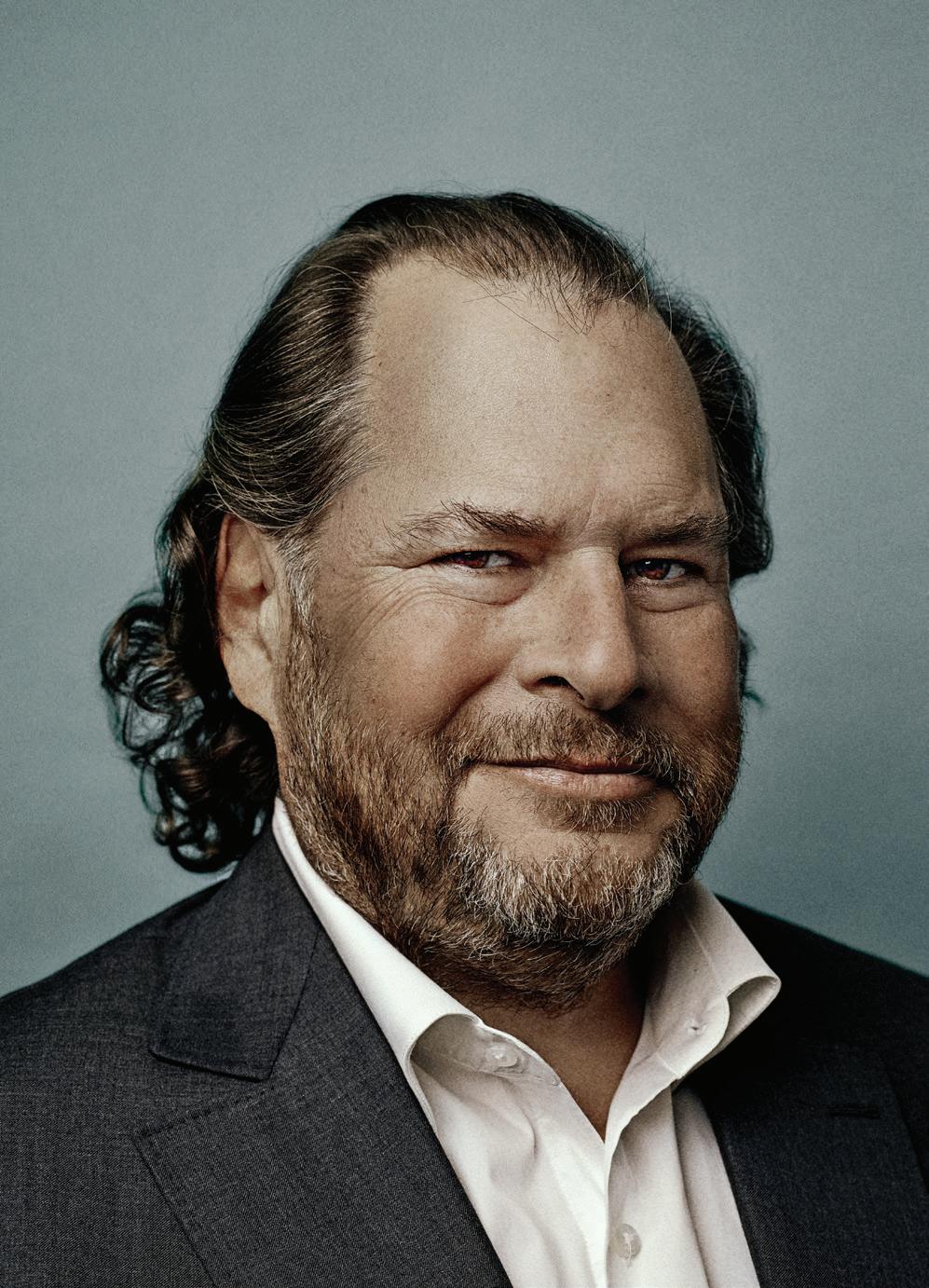 By Dan Bigman and Ted Bililies
By Dan Bigman and Ted Bililies

What happens when the newly empowered American worker meets a slowing economy? We’re about to find out. By Dale Buss
It may not be as sexy as winning new business, but in this economy, it’s even more critical. CEOs share strategies.
By Dale BussIn the reset to a buyer’s market, acquirers are (so far) shrugging off higher interest rates to nab the right opportunities. But while the game is much the same, the rules are definitely shifting. Here’s how to play.
By Russ Banham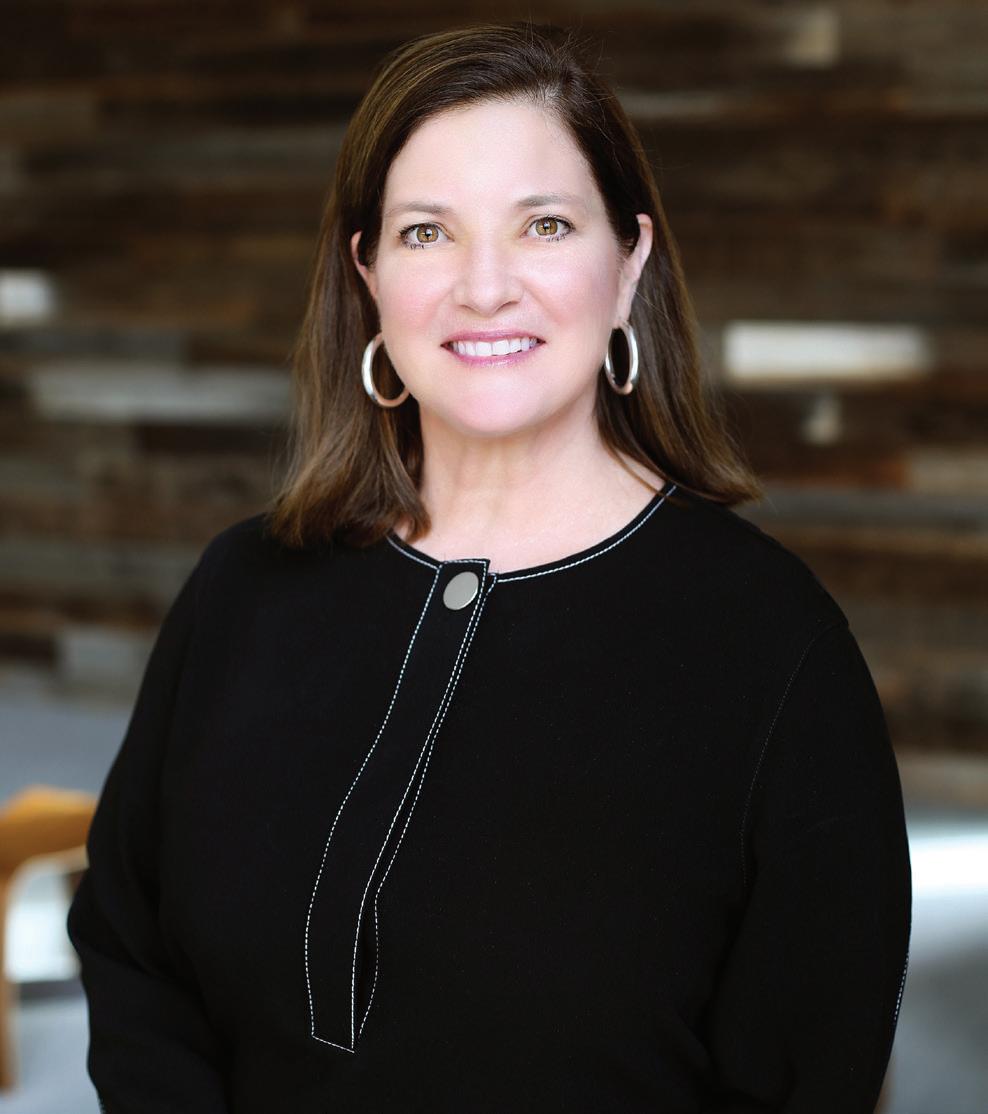
Even amid economic uncertainty, rising inflation, continued supply chain difficulties and myriad challenges, the theme of September’s gathering of CEOs, CHROs and business leaders was clear: Companies are still doing everything they can to add and keep great talent, and they need help doing so. Some highlights.
The past few years have made two things perfectly clear: the need to navigate uncertainty and the undeniable link between the health of one’s employees and the overall health of one’s company.
In fact, an Economist study commissioned by Cigna found that 86% of employees reported improved performance and lower rates of absenteeism after receiving treatment for depression. What does that mean for your business?
It means the right health care partner can be a strategic partner in business growth. That partner is Cigna.
Our plans and tools are already helping thousands of companies be more cost-e cient, more employee-centric, more compelling to new talent, and more future-proof by continually innovating to increase the vitality of their employees. Everything we do is designed to help you nurture a healthy work culture and improve employee productivity.
Together, we’ll help your employees achieve their best health, and help your business grow.
are business leaders prepping for a looming

new Chief Executive study has some
Melanie C. Nolen
Regional Report: The Midwest
The nation’s heartland is winning high-profile economic development projects, many in renewable energy and advanced manufacturing.
By Craig Guillot
EDITOR Dan Bigman
MANAGING EDITOR Jennifer Pellet
DIGITAL EDITOR C.J. Prince
ART DIRECTOR Gayle Erickson
PRODUCTION DIRECTOR Rose Sullivan
CHIEF COPY EDITOR Rebecca M. Cooper
CONTRIBUTING EDITORS Russ Banham, Dale Buss, Daniel Fisher, Marshall Goldsmith, Kelly Goldsmith, Garry Ridge, Jeffrey Sonnenfeld
EXECUTIVE
CEO Garry Ridge wanted to avoid the loss of top performers during WD-40 Company’s leadership transition. Here’s how he did it. By Garry Ridge
Chief Executive (ISSN 0160-4724 & USPS # 431-710), Number 316, Fall 2022. Established in 1977, Chief Ex ecutive is published quarterly by Chief Executive Group LLC at 105 West Park Drive, Brentwood, TN 37027. Wayne Cooper, Executive Chairman, Marshall Cooper, CEO. © Copyright 2021 by Chief Executive Group LLC. All rights reserved. Published and printed in the United States. Reproduction in whole or in part without permission is strictly prohibited. Basic annual subscription rate is $99. U.S. single-copy price is $33. Back issues are $33 each. Periodicals postage paid at Brentwood, TN and additional mailing offices. POSTMASTER: Send all UAA to CFS. NON-POSTAL AND MILITARY FACILITIES: send address correc tions to Chief Executive Group LLC at 105 West Park Drive, Brentwood, TN 37027.
Subscription Customer Service Chief Executive Group, LLC 105 West Park Drive Brentwood, TN 37027
615-592-1380
EXECUTIVE CHAIRMAN
Wayne Cooper
CHIEF EXECUTIVE OFFICER
Marshall Cooper
CHIEF CONTENT OFFICER
Dan Bigman
CHIEF COMMUNITY OFFICER
R.D. Whitney
DIRECTOR OF EVENTS & PUBLISHER, CORPORATE BOARD MEMBER
Jamie Tassa
VP, PUBLISHER, STRATEGICCXO360.COM
KimMarie Hagerty
DIRECTOR OF MARKETING Simon O’Neill
VICE PRESIDENT Kendra Jalbert
HR MANAGER / OFFICE ADMINISTRATOR
Patricia Amato
RESEARCH DIRECTOR Melanie Nolen
DATA SERVICES DIRECTOR Jonathan Lee
DIRECTOR, DIGITAL PRODUCTS Leigh Townes
ASSISTANT CONTROLLER Brittney Smith
STAFF ACCOUNTANT Marian Dela Cruz
MARKETING MANAGERS
Simone Bunsen, Christian Robinson
EVENTS & MEMBERSHIP MANAGER Rachael Gaffney
EVENTS COORDINATOR KP Wilinson
DATA ANALYST Denise Gilson
CLIENT SUCCESS MANAGER Victoria Campbell
STRATEGIC PARTNERSHIPS ASSOCIATES
Lara Morrison, Allison Roberto
RESEARCH ANALYST Isabella Mourgelas
CHIEF EXECUTIVE NETWORK
PRESIDENT Rob Grabill
EXECUTIVE DIRECTOR Chuck Smith
DIRECTOR OF OPERATIONS JoEllen Belcher
SENIOR MARKETING MANAGER Janine O’Dowd
DIRECTOR OF MEMBER SERVICES Brandon McGinnis
SALES SUPPORT ASSOCIATE Brittany Hochradel
Wisconsin loves to help all sorts of companies find their version of success. That includes yours. From site selection through construction, opening and expansion, we provide support to ensure your vision becomes reality. After all, your success may inspire other companies to relocate or expand here, too. That’s how we look forward.

lOve we what’s next-ers momentum builders game changers companies with vision world-first innovation industry revolutionizers competitive edge seekers
WE’RE ONCE AGAIN IN THE SILLY SEASON OF American politics. As difficult as it may be, the U.S. business community needs leaders of both parties to put aside their differences, use some common sense and remove barriers. Here are four places to start.
The defense of American business has been a bedrock principle of American government ever since our new nation’s ships were being plundered by the Barbary pirates, who seized our commerce vessels and held sailors for ransom. By 1800, the U.S. was paying an astonishing 20 percent of annual government revenue as “tribute” to the pirates. Only with the development of the Navy did the U.S. began to fight back and win.
Today, we face the same dilemma in cyberattacks, and we are repeating the policies that failed. Indi vidual companies often find it in their best interests to meet the demands of cybercriminals rather than report the crime or fight back. While that frequently resolves individual attacks, the payoffs incentivize criminals to continue targeting businesses, creating an endless, escalating spiral.
The only possible path to defeat this scourge is collective action by the Feds, which must mobilize resources and develop the will to unequivocally prosecute and destroy those who attack American commerce via the Internet.
U.S. laws that classify employees versus contractors are badly antiquated, open to wide interpretation and poorly adapted to today’s work environment. The IRS’s attempt to “clarify” this issue is providing guidance via form SS-8, which elicits answers to 44 questions, about half of which are open-ended and most of which pro vide no insights on how to properly classify people (e.g. “What types of reports are required from the worker? Attach examples”).
Rather than demanding that every contractor be an employee or making it difficult to maintain contract ing relationships, as some states do, wouldn’t a better policy be to ask both contractor and employer each year to voluntarily renew (or not) their contracting relationship? Should the contractor feel that the relationship has changed to an employee-employer relationship, both parties would have the opportunity to choose to change that status, rather than it being
forced on them. Congress can make this happen.

In 2018, the U.S. Supreme Court handed down a decision in South Dakota vs. Wayfair that allows each state to require any business that sells within its borders to collect and remit sales tax even if the business has no physical presence in that state. Every U.S. business with cross-border sales must now track the changing rules and thresholds in all 50 states and file reports and remit payments as it crosses each different threshold. Pennsylvania, for example, has a $500,000 annual revenue receipts threshold, while Maryland has a $200,000 or 200-transaction threshold. Worse still, most state rules are retroactive once you hit the tripwire.
For small and medium businesses, these rules are overly complex and unfair. Congress should enact and implement an annual revenue minimum to free small and midsized businesses from this patchwork of state laws. Or it should negotiate a standard cross-state tax rate for tracking and remittances.
The U.S. faces severe labor shortages that are crippling multiple industries, including agriculture, manufac turing, hospitality, food service and healthcare. At the same time, a lack of border security threatens the welfare and safety of border states. All this leaves CEOs in the lurch, unable to meet market demands for goods and services or plan for the future.
Congress needs to secure our borders and imple ment a working immigration policy that enables work-willing immigrants who share our values and are vetted for security and health concerns to legally enter and work in this country. Skilled professionals, including engineers and scientists, should similarly be vetted and welcomed to this country to continue our proud tradition of attracting innovators to our shores.
None of these issues are simple. But they’re not unsolvable either. Even in Washington.
—Marshall Cooper, CEO, Chief Executive Group
SEMICONDUCTORS HAVE EVOLVED from being devices found only in advanced electronics to being integral to virtually every electronic device on which companies rely. From the trucks that deliver our products and the computers that we use to send emails and track sales, down to the coffee machine in the break room, businesses cannot escape some relationship to semiconductors. The chip industry trickles down into almost all aspects of the U.S. economy, including electronics vital to national security, such as defense, cybersecurity, healthcare and domestic energy industries. To help encourage investment in the U.S. semiconductor industry, President Biden signed the $50-billion-plus CHIPS Act into law in August1 of 2022.
There are several factors that likely contributed to the passage of the CHIPS Act:
“Such a step-change expansion of the US semiconductor manufacturing industry over the next 5-10 years may likely have transformational impacts on the states and communities that receive wafer fab investments”
1. Covid lockdowns caused worldwide chip manufacturing to slow in 2020, while simultaneously skyrocketing sales in work-from-home electronics, virtual learning and healthcare industries, exacerbating a supply/demand imbalance.
2. The U.S. share of global semiconductor manufacturing has dropped from 37 percent to just 12 percent since 1990. Increasing labor costs and regulation have made it approximately 25-50 percent more expensive to construct and operate a semiconductor facility in the U.S. compared to overseas.2
3. Today, 75 percent of the world’s chip manufacturing is concentrated in East Asia. Investment-attracting policies coupled with attractive manufacturing wages have caused this area of the globe to dominate global chip production.3
The CHIPS Act is a bold play by the U.S. government to attract chip manufacturing investment to the U.S. and alleviate our dependence on East Asian chips. The cornerstone of the CHIPS Act is the “Advanced Manufacturing Tax Credit” (AMTC) of 25 percent of depreciable property of any “advanced manufacturing facility” associated with semiconductor production. Additionally, projects that qualify for CHIPS Act funding will also receive “coordinated permitting” between federal agencies to speed up the often one-year-pluspermits necessary to begin construction on manufacturing facilities.
The $52 billion CHIPS Act is predicted to stimulate over $140 billion in direct investments before the construction cutoff date.5 By comparison, South Korea recently offered up to 50 percent in investment tax credits to new semiconductor facilities, spurring over $151 billion in investment commitments between now and 2030 from a single large chip producer.6 Such government incentives and
As used
favorable operating structures have helped catapult South Korea to be the No. 2 global producer of non-memory semiconductors and No. 1 in memory semiconductors.7 Likewise, Taiwan sits securely in the No. 1 global position for overall semiconductor production, responsible for approximately 63 percent of global chip production between 2020 and 2021.8 While Taiwan has not doled out large tax incentives as readily as South Korea, the government did partake in spurring the creation of multiple semiconductor companies in the 1980s, and then housing them in a dedicated “science park.”9 Similar to Silicon Valley tech companies, this cluster of small chip makers competed, innovated and eventually grew into some of the largest semiconductor companies in the world. In 2020, Taiwan’s largest chip producer has grown to command a 54 percent share of the global semiconductor manufacturing market, the largest in the world by far.10 Considering the already $60 billion investment announcements in chip facilities in 2022 thus far and the historical success of tax incentives to the semiconductor industry, it is expected that the CHIPS Act will increase the U.S.’s global share of semiconductor production and reduce U.S. reliance on foreign chips.
Such a step-change expansion of the U.S. semiconductor manufacturing industry over the next 5 to 10 years may have transformational impacts on the states and communities that receive wafer fab investments. Growth in technical talent development, expansions in infrastructure, responses by academia to meet the demand for specialized degrees and movement by semiconductor industry suppliers are just a few potential examples of local impacts.
If you believe your business may qualify for CHIPS Act funding, keep an eye out for government rules, guidelines and updates on how to qualify and ensure that your overseas operations do not affect your eligibility. As new production facilities ramp up in the coming years, we may expect to see the global chip shortage ease. Leaders should understand how specific types of semiconductors operationally and financially affect their business, closely follow current and projected supply, and prepare for at least some degree of improvement over the pandemic-induced global chip shortage.
Darin Buelow (dbuelow@deloitte.com) is a principal and Alex Dunlap is a consultant at Deloitte Consulting LLP, where they provide clients with real estate and location strategy solutions.
1https://www.whitehouse.gov/briefing-room/statements-releases/2022/08/09/fact-sheet-chips-andscience-act-will-lower-costs-create-jobs-strengthen-supply-chains-and-counter-china/ | 2https:// www.semiconductors.org/wp-content/uploads/2021/09/2021-SIA-State-of-the-Industry-Report.pdf | 3https://www.trendforce.com/presscenter/news/20210305-10693.html | 5https://www.semiconduc tors.org/wp-content/uploads/2021/09/2021-SIA-State-of-the-Industry-Report.pdf | 6https://wccftech. com/samsung-increases-chip-investment-to-151-billion-amidst-50-tax-break-promises-in-korea/ | 7https://asiatimes.com/2022/07/in-chip-war-korea-spends-big-to-stay-ahead-of-china/ | 8https:// www.trendforce.com/presscenter/news/20210305-10693.html | 9https://history-computer.com/tai wan-semiconductor-history/ | 10https://www.trendforce.com/presscenter/news/20210305-10693.html
reserved. SOURCES: https://www.semiconductors.org/wp-content/uploads/2021/09/2021-SIA-Stateof-the-Industry-Report.pdf | https://www.trendforce.com/presscenter/news/20210305-10693. | html https://history-computer.com/taiwan-semiconductor-history/ | https://www.reuters.com /technology/us-chip-industrysplit-over-chips-act-benefits-intel-sources-2022-07-18/ | https://asiatimes.com/2022/07/in-chip-war-korea-spends-big-to-stay-ahead-of-china/ | https://wccftech.com/samsung-increases-chip-investment-to-151-billionamidst-50-tax-break- promises-in-korea/ | https://www.whitehouse.gov/briefing-room/statements-releases/2022/08/09/fact-sheet-chips-and-scence-act-will-lower-costs-create-jobs-strengthen-supply-chains-and-counter-china/
Copyright © 2022 Deloitte Development LLC.
This publication contains general information only and Deloitte is not, by means of this publication, rendering accounting, business, financial, investment, legal, tax, or other professional advice or services. This publication is not a substitute for such professional advice or services, nor should it be used as a basis for any decision or action that may affect your business. Before making any decision or taking any action that may affect your business, you should consult a qualified professional advisor. Deloitte shall not be responsible for any loss sustained by any person who relies on this publication.
Insights from Chief Executive Group’s CEO Confidence Index, a widely followed monthly poll of CEOs, including members of the Chief Exec utive Network (CEN), our nationwide membership organization that helps C-Suite executives improve their effectiveness and gain competitive advantages. For more information, visit chiefexecutivenetwork.com.
A GROWING NUMBER OF CEOS are expecting many of the current eco nomic challenges to have subsided by the fall of 2023, at least according to the most recent data from Chief Executive’s CEO Confidence Index—our monthly poll of U.S. CEOs on their short-term strategies and outlook for business.
In September our leading indicator of CEO confidence clawed back months of losses, with much of the gain happening in August. CEOs polled said they are seeing early indicators that by this time next year, the country will be in a recovery—not a recession.
“Optimism that supply chain issues resolve, Ukraine/Russia war is resolved, business across the globe improves and inflation is moderated without spiking interest rates too high from here” are the reasons a CEO of a biotech company participating in our September poll gave for forecasting improving conditions. He was echoed by others who cited the mid-term elections being behind us, the end of the Fed’s tightening policy, a loosening labor market and stablizing energy crisis.
Underpinning all of this, CEOs tell us, is insatiable demand. Earlier this year, CEOs told us they feared the Fed would wear down consumer buying power. It hasn’t happened. “We have the highest order book in our history. We are adding equipment and personnel to grow our production capacities and capa bilities,” said Scott Glaze, CEO of wire manufacturer Fort Wayne Metals.
“Demand is holding up, and we are seeing some easing of inflationary pressures on the supply chain and raw materials side,” said Will Symonds, president of global houseware company OGGI.
And while labor challenges have so far limited companies’ ability to deliver on that demand, many are reporting the beginning of a shift in the market. Mark Rubenstein, CEO of hospitality service provider A Head for Profits, says by keeping focus on tapering inflation, the Fed “will likely help ease labor pressure, which I see as the most impactful business concern currently.”
Here’s hoping.
—Melanie Nolen, Research Editor and Isabella Mourgelas, Research Analyst

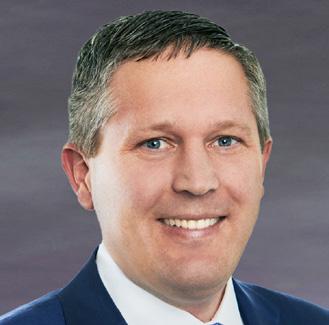
How are business leaders prepping for a looming recession?
A new Chief Executive study has some answers.
ECONOMIC UNCERTAINTY is affecting every business these days, but not always in the same way—which is why peer performance data is invalu able in these challenging times. But how to get it?
To help you gain a better picture of how and what your competitors are doing, as well as how your company stacks up, Chief Executive reached out to thousands of CEOs, presidents, owners and CFOs at U.S.-based companies of nearly every size and sector. We asked them to share key KPI data, really nitty-gritty stuff like pricing changes, staffing costs and turnover data, how many days receivables/payables are tak ing, changes in R&D budgets and more, and then we analyzed it all and sliced it up in every way you can think of, by size, by industry, and so on.
The results? They were eye-opening, to say the least—and obviously a lot more than we could cram into an issue of the magazine—so we put the full results in a new study, Chief Executive Group’s 2022 Financial Benchmarks Report for U.S. Companies, available at chiefexecutive.net/benchmarksreport. For now, here are some of the top-line results we found most interesting. How do you compare?
According to our survey, 41 percent of U.S. companies are projecting their annual revenues to grow by 10 percent or more in 2022. A big contributing factor to this, of course, are the inflation-driven price increases companies are implementing.
BY MELANIE C. NOLENMore companies are raising prices in 2022 than in 2021—81 percent vs. 72 percent. The extent of those increases varies, but the great majority report numbers between 2.5 percent and 15 percent.
And while small companies (by annual revenues) tend to be more reluctant to increase prices compared to their larger peers, they are also the group with the highest proportion forecasting revenue declines this year—which showcases the importance of price in creases in navigating this environment.
As one might expect, sector also plays a prominent role. For instance, 53 percent of manufacturing compa nies focused on consumer goods forecast ending 2022 with revenue growth in excess of 10 percent—the larg est rate across all sectors. It’s no coincidence that these are also among the companies most likely to implement substantial price increases (7.5 percent or more) in 2022, compared to other industries.
Net revenue per employee is another important metric to consider in this economy, as labor costs con tinue to skyrocket. According to our research, median total net revenue per employee in 2021 was $225,000, with 35 percent reporting theirs falling between $100,000 and $199,000.
And while company size has a direct correlation to this metric, it also varies largely based on industry: 30 percent of wholesale/distribution companies and 22 percent of energy companies have total net revenue per employee of at least $1 million, far more than any other sector.
When we’re talking inflation, we’re of course talking costs. So how is it hitting companies?
We found that the median projected cost of goods sold (COGS) as a percentage of net revenues is 41 percent in 2022 (average of 45 percent), an increase from 2021 (40 percent and 43 percent, respectively). While a 1 per cent increase may seem modest, it can have a material impact on profit margins.
Construction companies have the highest COGS in 2022, with a median of 73 percent—down from 75 percent in 2021 but the highest across all sectors.
In response to rising wages, 52 percent of companies said they are increasing or have increased prices to match wage increases. Overall, the larger the company (by annual revenues), the more likely it is to invest in automation to curb the impact of wage increases, particularly when it comes to back-office operations.
In the restaurant industry, 75 percent of companies said they are increasing prices in line with wages, and 58 percent said they are investing in automation to reduce the number of employees specifi cally in response to rising wages. This is only second to the retail industry, where the study found 60 percent of companies were adopting the same strategy.
COGS as a percentage of net revenue, all sectors
What
Reducing costs
Increasing average prices
Investing in automation
Investing in automation
line
other technologies
front-line
other technologies
increases
10th Percentile
25th Percentile
50th Percentile
75th Percentile
90th Percentile
Mean
EBITDA as a percentage of net revenue, all sectors
number of back-office employees
Reducing profit expectations
Increasing average prices more than wage increases
Investing in automation and technologies
middle managers
10th Percentile
25th Percentile
50th Percentile
75th Percentile 90th Percentile
Mean
Less
Down No Change
In our current economy, all eyes are on profitability. While median EBITDA in 2022 is 14 percent of net revenue, accord ing to the benchmarking study, average EBITDA as a percentage of net revenue is projected to be 16 percent, down from 17 percent in 2021.
Here, too, size plays a role, but this time, the peer groups at both ends of the scale show an advantage. Companies with less than $10 million in annual revenues and those with more than $1 billion in an nual revenues enjoyed the highest median EBITDA as a percentage of net revenues in both 2021 and 2022, at 15 percent.
As for sector (another important component when benchmarking perfor mance), the study found real estate and pharma as the two industries with the highest median EBITDA as a percentage of net revenue in 2022. Real estate, at 23 percent, showed no change from the year prior, but pharma/biotech, at 18 percent, is down from 23 percent in 2021.
When evaluating EBITDA per employ ee, a figure of less than $50,000 is quite common, and nearly 40 percent of com panies represented in the benchmarking study reported that figure. Fewer than a quarter reported EBITDA per employee of $150,000 or more.
As you’d expect, sector is critical, and it’s been good to be in the energy business. One-third of energy companies polled reported EBITDA per employee of at least $400,000—the highest of all industries. No energy company reported EBITDA per worker under $50,000 for 2022. Will that last into a recession? We’ll see.
Utilizing data from U.S.-based companies, Chief Executive’s Financial Performance Benchmarks
an
into pricing strategies, departmental staffing costs and turnover ratios, days receivables/payables, R&D budgets and other key performance indicators
help you benchmark your operations against peers and drive growth. For more information, visit chiefexecutive.net/benchmarksreport.
is proud to partner with Salesforce to help accelerate
businesses around the world.
3M SURVIVED TWO WORLD WARS, the Great Depression and dizzying changes to the U.S. economy since it was founded in 1902 to produce sandpaper and grinding wheels. The former Min nesota Mining & Manufac turing Co. had nearly $3 billion in cash on the books as of June 30, 2022.
So why did 3M put one of its subsidiaries in bankrupt cy the following month?
J&J said only a bankruptcy court could pay claims in an orderly manner.
The march to bankruptcy court started in the early 1980s after asbestos manufacturer Johns-Manville filed Chapter 11 to resolve a wave of personal-injury lawsuits. In 1994, Congress amended the Bankruptcy Code to allow companies to settle asbestos litigation by contributing assets and insurance proceeds to a trust to pay present and future claims.
How solvent companies leverage bankruptcy to resolve lawsuits.

The answer is becoming increasingly common as mass-tort litigation spirals out of control in the U.S.: It seemed like the least-bad alternative. In 2008, 3M had the misfortune to buy Aearo, a manufacturer of military earplugs, for $1.2 billion. Then plaintiff lawyers discovered internal documents they said proved Aearo had covered up problems with the devices. Soon 3M faced more than 230,000 claims by service members claiming permanent hearing loss, representing billions of dollars in potential liability over a product that generated less than $50 million in mili tary revenue over its lifetime.
Add in a sympathetic federal judge in Florida who stripped 3M of its most im portant defense—that it was a government contractor making a government-approved device—and 3M suddenly had a very big problem on its hands. After racking up a mixed record in “bellwether” trials, including one $70 million jury verdict, 3M put Aearo in Chapter 11 bankruptcy, saying “the tort system is no longer a viable forum to resolve this litigation.” In doing so, 3M followed the lead of highly profitable Johnson & Johnson, which last year placed the unit responsible for its iconic Johnson’s Baby Powder into bankruptcy to resolve thousands of asbestos suits.
The difference with today’s bankruptcies is that solvent companies are doing it—and plaintiff lawyers and some legal academics are crying foul. University of Georgia Law School Professor Lindsey Simon, in a widely cited 2021 article in the Yale Law Journal, called sol vent companies that use Chapter 11 to sort out their tort liabilities “bankruptcy grifters.”
“Case by case, exception by exception, bankruptcy grifters have infiltrated the Chapter 11 process,” Simon wrote.
Johnson & Johnson used an aggressive technique known as the “Texas Two-Step,” forming a special subsidiary to hold the talc liabilities and pay claims, backstopped by a guarantee of the parent company’s assets. A bankruptcy judge in Delaware blessed the maneuver, but plaintiff lawyers have contest ed it at the Third Circuit Court of Appeals, saying it denies claimants their day in court.
3M didn’t use the Texas Two-Step, and its caution may wind up costing it billions. In August, U.S. Bankruptcy Judge Jeffrey J. Gra ham denied the company’s request for a stay of the earplug litigation, saying that 3M’s offer to cover Aearo’s litigation costs after it burned through several insurance policies made the bankruptcy economically meaningless.
Daniel Fisher, a former senior editor at Forbes, has covered legal affairs for two decades.
Johnson & Johnson, like 3M, denies the allegations against it. But facing the prospect of $100 million to $200 million a year in litigation expenses for “decades to come,”
In his order, Judge Graham splashed cold water on the idea that bankruptcy threat ens mass-tort claimants’ constitutionally guaranteed right to a day in court, however. With more than 290,000 claims, he wrote, it is “accurate to say that it is unlikely” most plaintiffs will get a jury trial regardless of how the litigation proceeds.




More hours in the day would make you a better leader. Here’s how to get them.
JORGE GONZALEZ HAS A GREAT track record as the CEO of City National Bank in Miami. Even when the business is going very well, he encourages his leaders to get out of their comfort zone and keep asking, “How can we do even better?” His organization is not as large as the huge national banks. He feels this size differ ential can actually be an advantage in terms of increased nimbleness, creativ ity and responsiveness to customers.
Bonus Round
Jorge taught us a wonderful three-part exercise that we are using with leaders at all levels in any organization. In part one, ask each leader, “If you were given two bonus hours per week, to do whatever you believe what would be in the best long-term interest of the company, how would you spend this time?”
team members. Many note that spending more time developing people would both be beneficial to the company and add meaning to their lives.
Here is the problem: Although leaders almost always say they would prefer to spend more time creating the organization of the future and developing the leaders of the future, they already feel over-committed. Where will this two hours come from?
In part two of this exercise, Jorge deals with the reality of overcommitment by asking each leader, “If you were forced to eliminate two hours of your existing work load, what would you stop doing?”
Creativity kicks in again. Leaders start coming up with opportunities to both eliminate unneeded work and to delegate more responsibility to their team mem bers. A common concern then begins to be expressed: “This sounds great to me, but what will my manager think?”
Kelly Goldsmith is a professor of marketing at Vanderbilt University’s Owen Graduate School of Management.
Marshall Goldsmith has been ranked as the world’s No. 1 leadership thinker and coach.
His 44 books include the New York Times bestsellers What Got You Here Won’t Get You There, Triggers and MOJO
When we observe leaders answering this question, their eyes light up! They immedi ately begin to get creative. We have seen two major themes emerge from their reflections.
• Creating the organization of the future: When leaders discuss the challenges and opportunities their organization will face in the future, they focus on long-term strategy—not only for the company but also for their part of the business. Taking a twohour break from “what is” gives them the opening to consider “what could be.”
• Developing the leaders of the future:
When leaders share what they are most proud of, they almost invariably mention the mentoring and development of high-potential
This question leads to part three of the exercise. Leaders are asked to sit down with their managers and share their ideas con cerning what to add and what to eliminate. While some modifications may take place based upon manager input, managers, more often than not, tend to agree with their direct reports—and appreciate their creativity.
As a chief executive, start with yourself. Challenge yourself to add two great hours and eliminate two less meaningful hours from your work life every week. Lead by example. Describe what you learned in this exercise to your team members. Then ask them to complete parts one and two of the exercise on their own and, finally, to complete part three with you.
We love this exercise. It empowers lead ers to take responsibility for their work week, it inspires creativity, and, on a much more personal level, it makes each week more enjoyable and meaningful.
Thank you, Jorge!
ACROSS THE LABOR MARKET, signs suggest we remain in a seller’s market as employee resignations remain higher than normal and job candidates are closely evaluating why, how and where they work, with many choosing jobs that offer more flexibility. Among nearly 300 CEOs participating in Chief Executive’s recent Confidence and Workforce survey, 85 percent reported higher or the same voluntary turnover compared to one year ago (see chart at right).
Many have taken action to boost their appeal to existing and pro spective employees (see chart below) and/or are exploring longer-term measures, from changes to compensation practices to holistic well-being initiatives. Tangible, forward-looking steps and questions CEOs may con sider to solve the labor shortage puzzle include:
• Total compensation and pay equity: In addition to implementing signing bonuses and pay increases to attract job candidates and soften inflationary impacts for current employees, leaders should consider longer-term plans to adjust their merit-increase process and incentive-based pay, with individual contributions and performance to be more equitable and results oriented. They should also consider broader opportunities to provide equity ownership in the business.
• Employee benefits: The rising cost of healthcare premiums and larger deductibles are putting more financial pressure on employees. Business leaders should work closely with their benefits administra tors to find creative ways to lower the overall cost of benefits while creating benefit plans aligned with the needs of the workforce. They should also consider opportunities to provide low-cost loans and/or crisis funds for employees.
• Skills development: Public/private initiatives to help prepare our workforces for the future are gaining traction. Vocational- and STEM-related programs leverage federal and state grants to provide apprenticeship and skill certification opportunities. Traditional internal training programs are generally not designed for the multiyear invest ment needed to develop the skills and experience required.
• Flexible work arrangements: Beyond providing the technology to enable knowledge workers to work remotely and/or utilize a flexible work schedule, business leaders should consider creative ways to connect people. Working remotely may be more productive for some than others. The isolation can create engagement and loyalty challenges, especially for new hires.
Managers may also need training and tools to help them lead a geographically dispersed team. What support are you providing managers to help them be efficient and effective? How are you com pensating those who cannot work remotely in the spirit of fairness (e.g., balancing workload, more flexible hours, longer break times, additional days off, rewards and recognition, etc.)?
Expanding
• Employee well-being: More than a third of organizations recognize the importance of well-being to workers’ overall health. Some are launching holistic well-being programs and/or training managers to help reduce the stigmas employees may experience when seek ing mental health assistance. CEOs may consider assessing their organization’s approach to employee well-being and specific benefits offered, including the metrics used to measure outcomes and the return on investment.
• Stay interviews: Stay interviews are growing in popularity as a way to increase retention rates, help employees de-stress, increase their sense of belonging by linking what they do to the vision and mis sion of the organization and learn how workforce-related investments are viewed. Some organizations are requiring leadership training on conducting stay interviews and requiring them to be performed at least two times per year.
Even as companies adapt to address changing expectations of our cur rent and future employees, solving the labor shortage puzzle sometimes feels like a catch-22. There are more than enough job seekers for the many open positions that remain unfilled. Yet, they may not possess the desired knowledge, skills and experience. Organizations seek a diverse slate of candidates but often lack visibility to diverse candidate sources. As infla tion rises, companies look for ways to reduce operating expenses even as compensation and benefit increases are being used to attract job candidates and retain employees. To solve this puzzle, business leaders will need a balanced approach, starting with empathy for their employees and an authentic, visible and transparent leadership style.

I HAVE STUDIED TOP LEADERSHIP exits for 40 years, starting with the work done for my book The Hero’s Farewell. The most traumatic leadership change is a mon arch’s departure, because it only happens following a palace revolt or the death of the leader.
(if not always smoothly) and helped guide former colonies through peaceful transi tions into independent statehood.
The end of a 70-year reign is not a tragedy of a premature passing—but still represents the loss of a bridge to our historic past.
So it is with the passing of Queen Elizabeth II. Her death is emblematic of the cultural, stra tegic and emotional complexity of such an event. Her stakeholders, in her case, subjects, had a deep emotional bond with her as the regal em blem of their nation. With her careful digni ty and thoughtful diplomacy, she made few public missteps, despite backstage palace intrigue. We fought two wars against Britain, but we join her nation, our strongest ally, as they mourn the passing of their queen.
Few of us are royalists or monarchists, but Queen Elizabeth was a global force as a prin cipled woman leader, accepting the crown at age 26 while still mourning her father, then surviving to be the longest-reigning mon arch in world history. She led as symbolic head of state through 15 different heads of government and 15 U.S. presidencies.
In corporate jobs, we rarely encourage such long-reigning leaders. Their inspiring vision and continuity of command can forti fy admired cultural values while providing stability, but they can also become overly invested in their identities as leaders. Such monarchs in industry often undermine successors and ritualize traditions that need to change. Potential successors can become discouraged and depart.
Long-Reigning Leaders Armand Hammer led Occidental Petroleum from 1957 until his death in 1990 at age 92. The company stumbled in the aftermath of his legacy of Libyan dependence for decades, finding its strategic footing only in the last two years. FedEx founder Fred Smith stepped down as CEO after over a half century of command, with people eager to see how his successor, Raj Subramaniam, a longtime FedEx insider, will fare. Ninety-three-year-old Rupert Murdoch’s patriarchal control of News Corp. was so worthy of a soap opera that HBO actually created one modeled on his reign.
Jeffrey Sonnenfeld is senior associate dean, leadership studies, Lester Crown professor in management practice at Yale School of Management, president of the Yale Chief Executive Leadership Institute and author of The Hero’s Farewell (Oxford University Press, 1988). Follow him on Twitter @JeffSonnenfeld.
Our parents, our grandparents, our selves—we knew of no other British monarch. She was a revered head of state and a reminder that Machiavelli clichés are wrong—leaders can be both loved and respected, hardly the tradeoff that Vladimir Putin and too many others seem to feel.
Paradoxically, she was a moral pillar of tra ditional values and also a bridge to the needed changes guiding our future—regal identity balanced by personal humility. Her traditional values—integrity, hard work, patriotism— forged strong bonds across the Atlantic.
She embraced ethnic and racial diversity as well as other religions, with an especially important embrace of the Islamic new comer to Britain. She embraced commoner spouses for her children and grandchildren
And so it was for Queen Elizabeth. Her frustrated, 73-year-old son Charles, now king, endured the longest royal apprentice ship in history as her heir apparent. For decades, it resembled an extended adoles cence, giving him plenty of opportunities to misstep while trying to avoid the shadow of his mother’s revered leadership.
Companies, like countries, are trauma tized by the departure of a monarch, but we cannot diminish the value they created, as much as the succession can be difficult. Queen Elizabeth’s death was inevitable and expected but is still a somber moment in the life of her nation. She was handed a unique leadership task and mastered it with dili gence and dignity. She is a reminder of the inextricably intertwined nature of the sub stance and symbolism of leadership and how very important it is to the life of a nation.
To learn more about how inspiring businesses are leading the way to a strong economy, visit ArkansasEDC.com/ whyarkansas

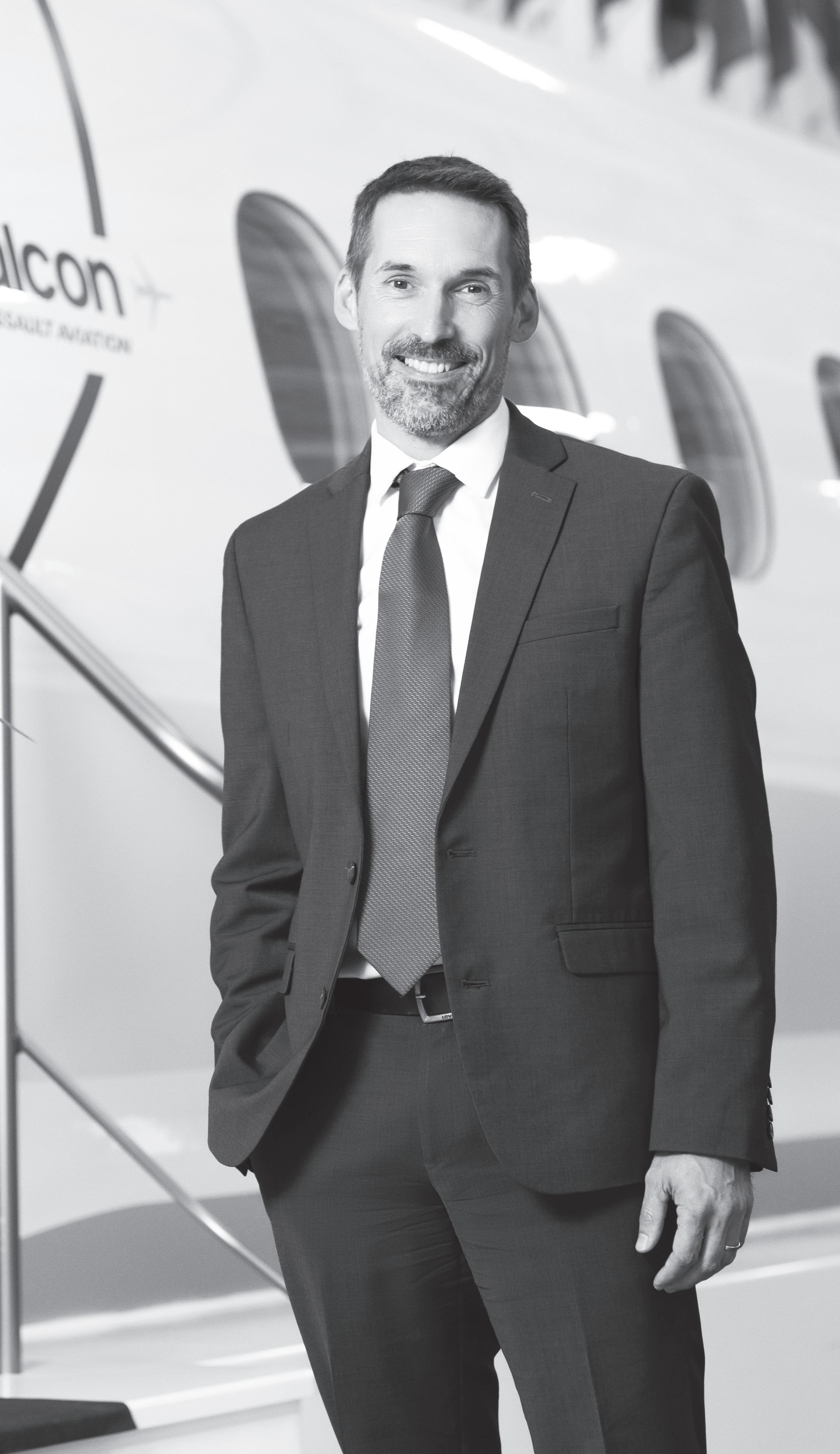



“
Arkansas is the perfect fit for Dassault Falcon Jet because it has an environment that encourages business and attracts the best people. And the people are the key to our success.”
Sebastien Deltheil - General Manager, Completion Center Dassault Falcon Jet, Little Rock
Winners of our 5th annual Patriots in Business Award weigh in on what they’ve learned—and how they’ve prospered—from their veteran and military hiring programs.
AT A TIME WHEN TALENT is hard to come by, veteran and active duty em ployment initiatives enable companies to support America’s military families in a meaningful way while also gaining access to a pool of highly skilled workers, many with leadership experience. It’s a double win that GuidePoint Security and John son & Johnson—winners of the Patriots in Business Award presented annually by Chief Executive and Thayer Leadership—are quick to acknowledge.
“Almost 20 percent of our organization consists of veterans, many of whom received some relevant training in cybersecurity or intelligence while serving our country,” says Michael Volk, founder of GuidePoint Security. “The military provides a great environment to recruit cybersecurity talent. Additionally, we are in a position to not only benefit from this talent but also to provide good opportunities to those who served when they transition out of the military—it’s a win-win.”
Johnson & Johnson CEO Joaquin Du ato echoed the sentiment, noting that hiring veterans fits with his company’s purpose-driven and values-based culture. “At Johnson & Johnson, we are grounded in ‘Our Credo,’ which means putting the needs and well-being of the people we serve first,” he says. “Living these values means that we have a responsibility to our employees, many of whom are veterans or service members. These individuals are valued members of our communities, and their military experience contributes to our business success.”
We asked this year’s winners to share their best advice on why and how to work with active-duty military members, veterans and their families. Here’s what they had to say.
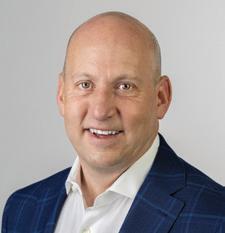
The Why: Organizations need to be more cre ative.... We developed GuidePoint Security University to work with those transitioning out of the military to chart a career path across a range of cybersecurity disciplines based on their training and interest. Certain non-cyber skills translate well into a cyber career with the right focus and training, and so we’ve learned to take alternate routes to bringing in good talent to grow and ultimately help support our customers.
The How: Understand each branch’s transition programs, as they can be very helpful—oftentimes helping to defer some onboarding/training costs. It’s important to be real clear on what skill sets and experience you are looking for—and relay this information to the transition groups with whom you are working. Understand that veterans will require some coach ing on how things are done in the “civilian world,” but almost always have finely honed technical skills, developed over their career. Plus, the discipline, drive and leadership qualities the military embeds in almost all veterans is really helpful in the civilian world.

The Why: Supporting veterans means support ing the entire military-connected community, including their spouses, children and caregivers. We incorpo rate the unique strengths and needs of this community through company-wide programs that are part of the everyday function of our business.
The How: Engage with the military-connected community as part of your organization’s overall approach to your business. For instance, we proudly partner with many veteran-owned suppliers. We have also incorporated this community into our overall recruiting and talent management strategy. Remember: This community brings unique strengths as leaders and bridge builders, two skills that are valuable in the boardroom and the battlefield.
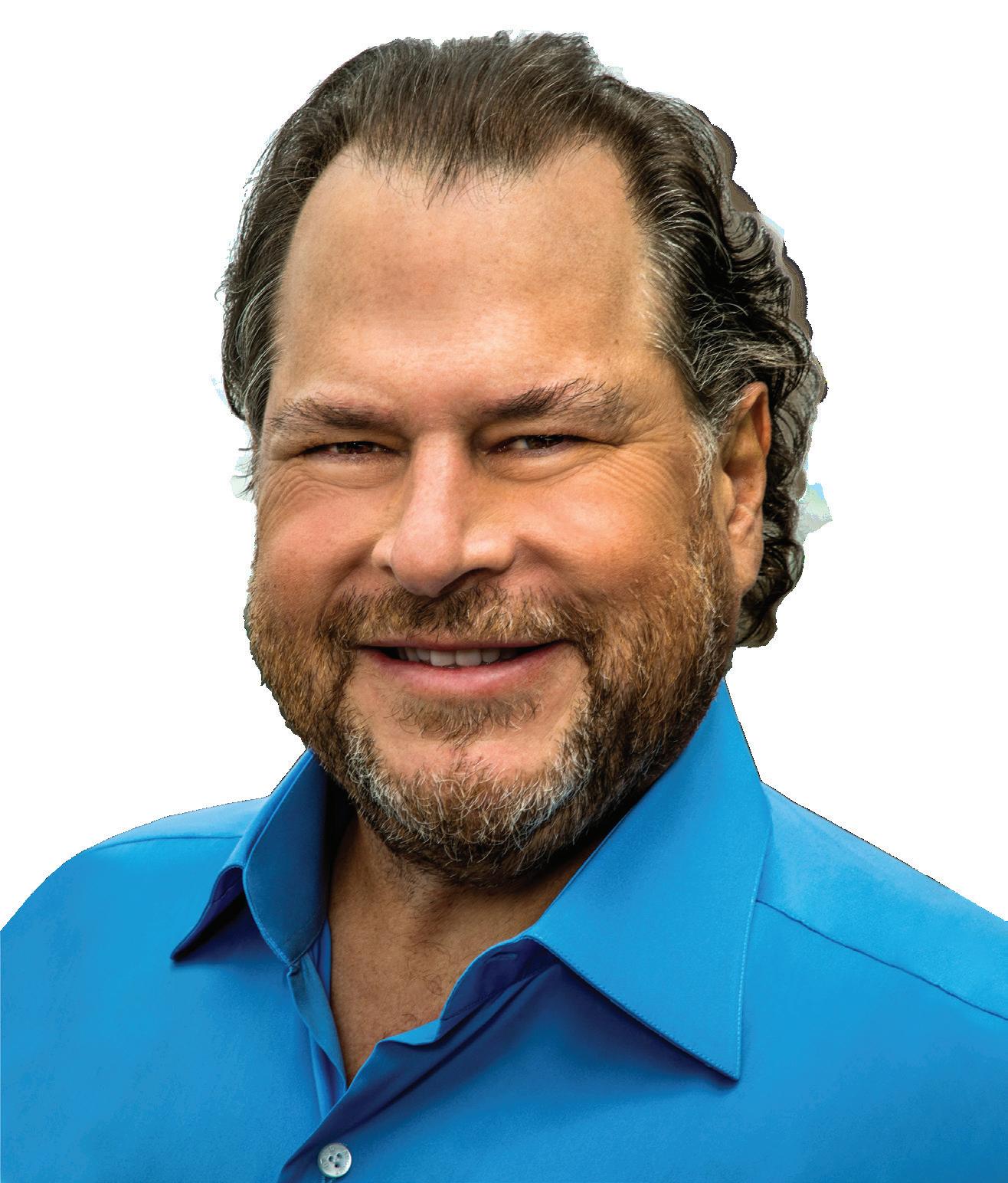

AFTER A LONG STRETCH OF undershooting investors’ expectations for Economic Profit (EP)1 growth and Total Shareholder Returns (TSRs)2, OEMs find themselves in an unfamiliar role: high performers.
Automotive OEMs have historically struggled to deliver the typical profit growth expectations set for most in dustries. The automotive industry’s high capital intensity, narrow margins and long product cycles challenged companies’ ability to consistently grow EP.
However, as new-vehicle supply tightened, expecta tions for battery-electric vehicles (BEV) rose, vehicle pric ing increased and investor expectations began to rise.
The best measure of a company’s success is delivering superior shareholder returns compared to its industry peers. Since shareholder value is driven by investor expectations of future cash flow and EP growth (See S&P 500 Warranted Value of Discounted Economic Profits vs. Actual Traded Value chart, below), EP has been used as the profitability metric for AlixPartners’ Automotive Value Creation study.

To sustain the recent increase in their TSRs, OEMs, like any other public company, will need to exceed investors’ already-high expectations for EP growth.
To understand the backdrop, consider the three-year period leading up to January 2020. During this time, the industry’s EP growth was challenged as margins were

squeezed by declining global volumes and high fixed costs. As a result, OEM TSRs underperformed the S&P 500, delivering 5 percent TSRs versus 15 percent for the broader market.
However, from December 2020 to December 2021, investors raised their outlook for OEM EP growth as supply tightened and pricing firmed, reflecting an expected rebound in U.S. auto demand, including increasing demand for BEVs, greater OEM pricing power and emerging growth in higher-margin and recurring subscription-based software and service revenues (See Growth in Investor Expectations and Shareholder Returns chart, above).
With this improving outlook, investors have priced in roughly $25 billion in EP growth from $31 billion in 2021 to $56 billion in 2023. The result: 31 percent TSR3 for OEMs (versus 29 percent for S&P 500), more than quadru ple the TSRs delivered from 2016 to 2019.
To sustain the recent capital market momentum, OEMs will need to not only meet but exceed these rising inves tor expectations for future EP growth.
A deeper look into the 2021 to 2023 growth expec tations highlights potential opportunities for OEMs. Out of nearly 40 OEMs analyzed, the top six OEMs are expected to drive ~$21 billion or ~80 percent of the total EP growth from 2021 to 2023. The forecasted EP improvement is highly reliant on sustaining increased
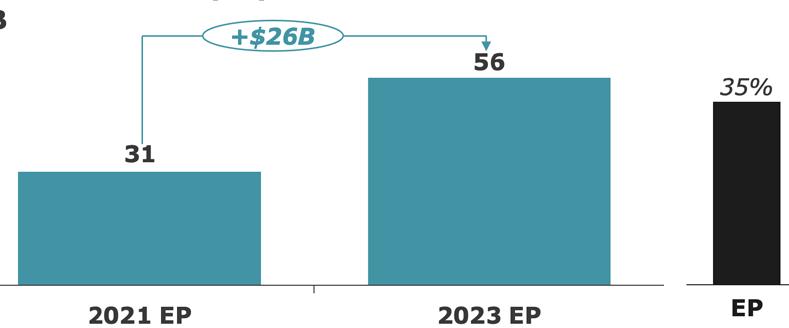
pricing power, which for new vehicles rose ~30 percent in Q2 2022 versus Q1 2019 levels (See Pricing Growth of Top 6 OEMs chart, below).
OEMs will also need to navigate emerging head winds. Raw materials costs are volatile; the relative appreciation of the dollar versus the yen and euro; continued supply chain issues complicate procurement and operations; and consumer sentiments may be waning amid escalation in sticker prices, inflation and recession fears.

• Leverage fully loaded economic profit (EP) to inform and prioritize current and future industry profit pools at granular segments of customers, products, services and markets
• Understand where and why traditional and emerging competitors are capturing share of these profit pools
• Outline the strategy and roadmap, including key stakeholder requirements and incentives, for increased EP growth in new segments (i.e., EV, software, services, etc.)
• Develop granular understanding of internal sources of EP by market, brand/ model, parts, services, distributors and end consumer segments
• Leverage granular business understanding to build an information advantage vs. peers to execute differentiated strategies that maximize and sustain competitive advantages
• Optimize pricing, mix (i.e., models, parts, services, etc.), and market participation based on EP growth potential and grounded EP share gain expectations
• Fix or eliminate perpetual negative EP contributors due to poor market economics or inability to achieve a distinctive competitive advantage
These headwinds will lead to even further concen tration of market profit pools and OEMs’ EP growth opportunities. Understanding where and why these concentrations exist and how they might shift in the future is the key to proactively addressing the head winds and fully focusing resources—time, talent and treasure—on an agenda of the best opportunities for sustaining and accelerating OEMs’ recent profit growth (see table at right).
These steps require disciplined leadership from CEOs and top management to ensure a cross-functional focus on maximizing EP growth and long-term sharehold er value. The OEMs that succeed will not only sus tain top-quartile TSRs but will also build a reinvest ment advantage that will be difficult for competitors to overcome.
1Economic Profit (EP) is Earnings minus a charge for the capital employed required to generate those earnings
2Share price appreciation plus dividend yield 3TSRs from Jan 1, 2021 to Dec 31, 2021
• Re-optimize supply chain given re-shoring, changes in capacity and new technologies, considering implications for customers, internal technologies and operations, partner capabilities and financial returns
• Reduce unrewarded complexity by driving out hidden costs and eliminating waste, duplication and conflicting agendas in process (i.e., tighter alignment rather than silos across functions)
• Improve ROI on SG&A and R&D by focusing resources in areas of EP growth and competitive advantage and by increasing speed to market via roadmap optimizations
• Focus investment on strategies where returns over time will exceed the cost of capital; do not tolerate consistent value destruction unless there is a clear positive EP outcome for total company
• Evaluate strategic alternatives for negative EP assets and/or assets with perpetually declining EP (i.e., restructuring, M&A/divestitures, partnerships, etc.)
• Return excess cash flow to shareholders via buybacks and dividends if reinvestment in company is unlikely to exceed produce returns above the cost of capital over the investment horizon
Elements of an OEM Agenda to Maximize EP Growth Understand Size and Growth of Granular Economic Profit Pools
The Salesforce founder changed the world by ushering in the cloud computing revolution more than two decades ago. His latest disruption may have an even bigger—and more enduring—impact. “We’re not coming back the way we were.”
BY DAN BIGMAN AND TED BILILIESIT’S CREEPING UP ON 6 P.M., AND AT THE VERY TOP OF SALESFORCE TOWER, 41 floors above Bryant Park in the heart of midtown Manhattan, company founder and co-CEO Marc Benioff is having one of the more important discussions of his year. He’s holding court with an elite group of Salesforce superusers—“Trailblazers” in the com pany’s lingo. Over spring water and finger foods prepared by Michelin-rated chefs, surrounded by a panoramic view of New York City, they’re dissecting an early draft of Benioff’s September keynote for Dreamforce, the 40,000-person-strong annual takeover of San Francisco that’s the centerpiece of his year.
From a product standpoint, the purpose of this year’s presentation is the formal rollout of “Genie”—a substantial rewrite of the Salesforce data platform that’s at the heart of the $26.5 billion (FY2022 revenue) company, one that will allow for more “customer magic.” It brings drag-and-drop ease and efficiency to the customer-data revolution for companies from the enterprise scale of Ford down to midsize market ing agencies.

But exciting as it is, Genie isn’t what’s really resonating in the room. What’s really got them revved up is the idea of a “family reunion” at Dreamforce.
“The last time we all got together was in 2019,” a young superuser in a checked blaz er tells Benioff. “This is the first time we’re going to be back together since then. You should make a bigger deal about that.”
Benioff nods in agreement, looks over at his head of marketing, who meets his eyes. Connection. Reunion. Family. Got it.
It’s a tiny moment that speaks to some thing much, much larger: While Benioff’s style of business, liberally combining enviro mentalism, higher purpose and a Da vos do-gooder tag may elicit eye rolls in jaded news rooms and redder statehouses, it resonates like cra zy with millions of his customers and employees.
That’s because, in an era of social media bub bles and deepening societal disconnection, Benioff’s way—emphasizing social responsi bility, trust, environmental stewardship and massive charitable giving—is catnip to the community he’s convened. It makes them feel like part of something larger, something with meaning beyond software or nailing quar terly goals. It’s fueled Salesforce’s perennial presence atop best places to work lists around the world for more than a decade. And it is helping to propel one of the most incred ible growth stories in modern business, a revolution that, in many ways, may come to eclipse 58-year-old Benioff’s first disruption: leading software from desktop computers to the cloud.
The company’s 78,000-plus employees— up from 4,000 in 2010—are part of a global Salesforce “ecosystem” involving millions of businesses, independent consultants and app
makers generating more than $1 trillion of estimated economic activity a year, on track to hit $1.6 trillion by 2026.
From 2017 to 2022, the company’s net income clocked a compound annual growth rate of 35 percent, and its five-year total shareholder return is 57 percent, a performance helped by co-CEO Bret Taylor, who ascended to the job in 2021, and juiced by a recent string of blockbuster acquisitions, including Mulesoft for $6.5 billion in 2018, Tableau for $15.7 billion in 2019 and Slack for $27.7 billion in 2021.
Meanwhile, the company pioneered the adaption of what’s come to be known as the 1-1-1 model of corporate philanthro py—giving away 1 percent of profits, 1 percent of equity and 1 percent of employ ee time—annually. As a result, Salesforce has donated more than $500 million, and its employees have volunteered over 7 million hours of service time during the past 23 years. Benioff is personally one of the top philanthropists in the United States, donating more than half a billion dollars in the past decade, including $100 million in 2021 as part of his effort to plant more than a trillion trees to combat climate change.
This singular combination of doing in credibly well while also doing an incred ible amount of good led his peer CEOs to name Benioff Chief Executive’s 2022 CEO of the Year. “For more than two decades, Marc has been a towering exemplar of what it means to be an innovative and forward-thinking leader,” says Ken Frazier, the former chairman and CEO of Merck and our 2021 CEO of the Year, who served on this year’s selection committee.
“As the founder and CEO of Salesforce, he consistently has achieved exception al business and financial results for customers, employees and shareholders while standing tall in the public square for policies and principles that will foster greater sustainability, prosperity and eq uity within the business community and broader society.”
“Marc created a company and helped create an industry,” says Brian Moynihan, chairman and CEO of Bank of America
“For more than two decades, Marc has been a towering exemplar of what it means to be an innovative and forwardthinking leader.” —Ken Frazier, Former CEO, Merck
and our 2020 CEO of the Year, and also a member of this year’s selection committee. “Salesforce’s track record is among one of the premier companies in recent decades. At the same time, he has proved a company can deliver on profits and purpose and do it consistently. He has championed stakeholder capitalism and demonstrated its value.”
The creation story of Salesforce is well known: A young, talented programmer growing up in the heart of San Francisco during the wild days of the 1970s and ’80s, Benioff came of age as a top salesman at Oracle under Larry Ellison during the company’s most explosive period of growth in the ’90s. Rather than sticking it out for the lucrative long haul there, he quit, and with Ellison’s support, started Salesforce in his apartment in 1999.
For those who weren’t there, it’s hard to grasp how unconventional Salesforce’s model was at the time. Software was something you installed via disk on your desktop PC or the realm of secretive armies of “IT guys” and their inscrutable, blinking, overly air-con ditioned server farms. Benioff pushed for something new. Rather than buy and manage a room full of your own machines, you could simply lease his solution, a “software as a service” CRM housed “in the cloud,” on offsite servers his team monitored, upgraded and made easily scalable depending on your needs. Salesforce listed on the NYSE in 2004, and over the next decade, with a brash “No Software” marketing campaign and a series of bet-the-company pivots, Benioff proved to be that rare Silicon Valley founder who scaled his leadership in step with the explosive growth of his company.
All the while, he was pairing his desire for growth with a passion for charity, fueled by a family with a legacy of social service, including his grandfather, Marvin Lewis, a crusading trial lawyer known in San Fran cisco as the major force behind the creation of the Bay Area Rapid Transit system. As Benioff’s company grew and his personal wealth ballooned, so did his conviction that business had a more muscular role to play in society. Through his involvement with organizations like the World Economic
Forum, Benioff famously advocated for a new “stakeholder” capitalism model, with a strong emphasis on the environment and employee well-being.
Covid marked another transformational period for Salesforce. Benioff—to the dismay, at times, of other CEOs—was outspoken about adapting a more flexible workplace. Salesforce began practicing “success from anywhere,” allowing many employees to forgo ever coming into the office, a policy that remains in place today.
But Benioff has sensed a deep desire by many in the Salesforce ecosystem to get together—in person—once again. He’s now experimenting with the Salesforce Trailblazer Ranch. Modeled on GE’s legendary Croton ville Training Center, it’s a location-TBD out post where Salesforce’s culture can be impart ed to new employees and renewed by veterans in multiday offsites and team meetings. How that will come together is still, he admits, very much a work in progress. Like so much else in his world, The Ranch feels experimental, unconventional, a bit ahead of its time—and yet tough to bet against given the Salesforce track record, much like Benioff himself.

Under Benioff, the software company he started in his San Francisco apartment has ballooned into one of the most influential technology firms in the world, with a long-term revenue trajectory that shows no signs of slowing despite the decades.
Japanese have this great word, shoshin, this idea that everything has to be looked at anew. When we look at the pandemic, that was a moment where we all had to kind of say, “What’s really happening here, and how are we going to go forward?” Things that applied before no longer applied. The way we worked didn’t apply. The technology we were using didn’t apply. For a lot of CEOs, they were able to succeed because they started with a blank piece of paper and said, “Okay, now what am I going to achieve?”
Chief Executive talked with Benioff in late August about his journey from startup founder to enterprise leader, the changing role of the CEO and how he stays a step ahead of whatever comes next. The conver sation was edited for length and clarity.
It’s a time of tremendous change, a lot of volatility. How do you lead differently in times like these? What are the keys?
Number one—always number one—is know ing what is important to you and your core values. When you have this much volatility and this much change going on in the world, when things are uncomfortable or frustrat ing or difficult, it fundamentally gets back to: What is the most important thing to you?
What are your core values, and how are you going to operationalize those into your company or into your life or into whatever you’re working on? That is more important than ever.
At Salesforce, it’s trust, it’s customer suc cess, it’s innovation, it’s quality, it’s sustainabil ity. The values are your true north. When we went through the pandemic, one reason that we were able to succeed and accelerate was we just kept coming back to our values over and over again. What is it that we really want to achieve here? What is our number one thing that really matters to us?

You’re one of the few people who have gone from founder to enterprise CEO. You’ve had to continuously learn. How do you learn? How do you go to each level of leadership?
We talk a lot about beginner’s mind. The
People who tried to do what they were doing before found that turned into a series of obstacles for them. It prevented them from moving forward.
One of the reasons I enjoy going to Kyoto, Japan, a couple of times every year and going to those gardens is because it reinforces to me, are you working on your beginner’s mind? Are you taking time? We even bring that into our business at Salesforce, where we have Zen monastics come in and guide our executives through a beginner’s mind meditation. We just had one last week. We had 500 executives come together. We had two monastics there. A lot of our executives have never meditated before, but I think in today’s world, they need that kind of grounding. They really need that ability to put the stress, the anxiety, the fear away to get a little bit clear about what is it that they’re actually trying to achieve right now.
How do you carve out the time to do that? A meditation practice has really paid off for me as CEO. Because I had that before I even started the company, it’s paid off for decades where I’m cultivating my beginner’s mind. I’m trying to encourage my executives and my company to do the same thing.
At the start of every year, we write some thing called the V2MOM, which answers five questions: Vision, what is it that we want to achieve for the year? Values, what is the most important thing to us, in priority? Methods, how are we operationalizing those values? What are we actually doing? Value by value, how are we actually creating that into the business? Obstacles, what is preventing us from achieving each one of these values? And measurements, how do we know that we have
Bain & Company congratulates and celebrates Marc Benioff for the outstanding recognition in being named 2022 CEO of the Year.
Marc, the impact of your leadership will be felt around the world for decades to come. Congratulations to a very worthy honoree.
succeeded? What are our KPIs?
Those five simple questions are remark ably difficult for an organization or, some times, for an executive. And it’s going to change. When we went through the pandemic, all of those answers changed. So, you have to be ready to shift and change also. That’s one reason why you need to be developing a beginner’s mind, so that when you ask those questions, you’re not just repeating the same answers over and over and over again, that you’re trying to come up with something new.
You have spectacular people on your team. How do you put those A players in place, and when do you know to make a change?
In terms of management teams, different man agers and different executives have different capabilities at different levels of the business.
As the business scaled, we have had four or five CFOs, four or five heads of sales, four or five heads of technology, four or five heads of marketing, four or five heads of every major function in the organization, because different people are needed at different levels.
Sometimes, somebody can go all the way from the beginning of the company to where we are now. I’m an example, and my cofound er is an example, but not every person is going to be able to move in that kind of scale. So, that’s something that you just have to have your eyes open for. A lot of founders hold onto their management teams too long, or aren’t willing to hire quickly enough or fire quickly enough. In today’s world, hiring fast and firing fast become more important than ever.
Founders sometimes get tripped up by feeling loyal to the people who were with them at the beginning even when they’ve clearly outgrown the position. Any advice to CEOs in that situation?
It’s important to have loyalty, in our friend ships, in our marriages, in our relationships.
In business, loyalty also matters. But realism also matters. Being able to look and say, “Is
this person really going to get me to where I want to go?” If they’re not, you don’t necessar ily have to fire them or remove them from the company. Maybe they can be repositioned.
It’s not uncommon for a head of sales who is managing 10 or 20 people, or 100 or 200, or even 1,000 sales executives to not be the right person to manage 10,000 or 20,000 sales executives. That doesn’t mean they can’t be a great chief customer officer. It doesn’t mean they can’t still motivate and inspire a team, but maybe their role on the team can change. That’s extremely important. You have to have that flexibility when you’re looking at people.
How do you engage with people to make those calls? How do you know when it’s time to make these kinds of changes?
You have to trust yourself. If you lose the trust in yourself, then you’re in trouble. If I don’t trust myself and I don’t have trust and exude trust, then I’m going to have a problem. This has to be the highest value in the organization, because if you do end up with an executive where people don’t trust them, or they feel like there’s a problem, that’s an issue.
We all have had that situation where all of a sudden there’s an executive in the organi zation who people don’t trust. There could be an integrity issue. There also could be a substance abuse issue. There could be lots of things where all of a sudden people are like, “I am not able to trust this person’s ability to guide us or lead us or make a decision.” This is the moment where you have to come in and make an immediate change.
The thing about the Ranch idea was that it was clear to me that people still need to get together, but they were leery about coming to the office for whatever reason. We’re in the middle of a pandemic. So, I said, “Well, maybe they’d like to go to the Ranch.” Of course, there was no Ranch. It didn’t exist. Nobody understood what I was talking about. And I said, “Yes, we’ll have a Sales force Ranch. And it will be amazing and magical, and people will be able to go there and have an experience.” Everyone was ready to go. Of course, it didn’t even exist.
The Ranch is a code word for “we’re coming
“You have to trust yourself. If you lose the trust in yourself, then you’re in trouble.”
On behalf of
being

back in a new way.” It doesn’t have to be some place in Montana. It just has to express to ev erybody that everything’s changed, and we’re going to come back together in a new way.
It’s not that we aren’t successful or pro ductive in a pure digital environment; we are. In some cases, people will never come back to the office. That’s just how it is. Some CEOs get upset when I say that. We’re not coming back the way we were. We have to come back in new ways.
We’ve gone through the Great Resignation, the Great Relocation. Ultimately, this was the renegotiation between us and our bosses and ourselves and our families. What makes you hap piest? Where do you want to live? What do you want to do? What are you doing with your life? This is a very powerful moment for everybody. Everybody had a chance to look in the mirror and say, “Where am I?”
That’s why you saw a lot of CEOs leave their jobs in the last few years. Their renego tiation with themself was, “Well, I’m not in a place where I want to be, so I want to make a change.” When you look at that, then you can say, “Okay, what are some of these other areas now that we need to do?”
In the world, we need to look outside and say, “We need, I would say, a regeneration of our planet.” That’s what inspired us around the idea of planting a trillion trees. These things are extremely important right now, that we have to keep looking at how we’re getting to the next level. It’s a re-creation.
Is some of this about competing to hire more talented people?
Absolutely. You have two kinds of CEOs. Those who are giving mandates: “You must be in the office four days a week, that’s how it is.” Or reasons: “We need to be in the office for these five reasons, because we’re doing professional development, we’re launch ing this new product, we’re mentoring our young executives.”
If you can’t articulate your reasons, your
mandates are not going to work. They’re go ing to work against you. You can see now the number of employee letters that have gotten created because of mandates. You have to be aware that it’s a different environment, and how you’re communicating with people has to be different.
It’s not just here. I’ve been in Australia, Japan, Europe. I’ve been throughout the United States. It’s a little bit different every where, but it’s remarkably similar in that this has changed everybody.
You led one of the biggest revolutions in technology, the move to the cloud. Where do you see technology going in the years to come?
It’s becoming more than just the fabric of how we operate. We don’t even know when we’re using technology in a lot of cases. That’s also the scary part of technology, that it’s more intelligent and more automated and more real-time. That’s where you can see that cer tain countries have very significant surveil lance operations now. That is not where we were with technology only a few years ago. I recently landed at the airport from another country, and the customs officer who came in on the plane just had a camera. They didn’t even know my passport number, and they knew who I was. We’re on a new level with technology. We’re not going back.
It fundamentally is changing everything, and it’s also why values matter. We’ve seen how certain companies, especially in social media—and I’ve spoken about this to exhaus tion—have basically put their values aside to increase their monetization. They don’t care about the fundamental interaction with the consumer or what they’re doing with the con sumer. In foreign countries that maybe don’t have the same kind of watchdogs that the United States has, they don’t realize the kind of shenanigans that have happened from these social media companies.
On the positive side, we have the ability to be better educated, healthier, more connect ed to our friends and families. Today, you can go in and have a scan of your heart. You will know the exact health of your heart. My father did not have that opportunity. He didn’t know what the health of his heart was
“If you can’t articulate your reasons, your mandates are not going to work. They’re going to work against you.”
Congratulations to Salesforce’s Marc Benioff on being named 2022 CEO of the Year.
We celebrate our shared commitment to building a better world through innovation and the visionary leadership that makes progress possible.

until his doctor said, “You need to have a bypass operation.” Everybody has that story in their family from our generation. But in the future, I don’t think that will be true. People will know more about their health in real time. They’ll be able to tune their meds. They’ll have the ability to live longer, because we’re using technology in new ways.
You’ve been at the vanguard of a school of thinking that says, businesses should be a force for good. In the decade to come, how do you see the role of business changing?
Business is the greatest platform for change. This is a fundamental thought that permeates our whole company.
We manage for all of our stakeholders, not just our share holders. These are core values of ours.
We don’t use Milton Friedmanism. We’re using the idea that, yeah, shareholders are important, but employees are, customers are and our com munity is. Public schools are important, and the planet is a key stakeholder, which is why we’re a net zero company today, why we build products to help companies become fully sustainable. This is extremely important.
Some of our best leaders in the world today are not in government. They’re in our busi nesses, and we all know that. They don’t want to go into government because they don’t want to be thrashed around with a bunch of non sense. But these leaders need to be empowered and enabled to improve the world.
There’s been pushback though—some people have branded it “woke capitalism.” What do you say to that?
I understand how people can misinterpret that. What they don’t realize is that compa nies have these assets called employees in them. And in today’s world, with technology, if you’re not listening to your employees, you’re going to have a very serious problem as a CEO. People call it woke capitalism right up to the point where I’m not actually
listening to my employees when they have a serious problem.
[In 2015], our employees in Indiana were upset about a law that was being passed that was discriminating against their LGBTQ community. They asked us to talk to the gov ernor, Mike Pence, and say, “Please change the law,” and he did. But when we first did it, it was like some revelatory thought that we should be able to say, “Please don’t discrim inate against our employees. They’re upset.” But if I don’t advocate for my employees’ well-being, then who will advocate for them?
Maybe this isn’t the traditional role of the CEO, but it will never go back because employees are going to hold their CEOs ac countable for their values and also for taking care of them. My job, fundamentally, is to have my employees’ back. It’s not to support any one particular group or to advocate for any one particular belief or any of that. It’s just, “Do I have my employees’ back?” It’s go ing to make them happier, more successful, and more productive in my organization.
But if [your] employees don’t think you have their back or they’re afraid, then you won’t have the company that you want. Your employees have to feel like you’ve got their back. With so many crazy presidents, may ors, governors, elected officials all over the world, employees need to know that compa nies—who have tremendous resources—that there’s some button that they can push and say, “Help me.”
If they don’t feel that, they’re not going to stick around in your company. They’ll find a company that is that. It’s not woke capital ism. It’s just paying attention that you have many stakeholders. If you don’t realize that, then you’re blindfolded as a leader.
I heard a political leader, I won’t tell you who it is, but a significant one, recently saying, “Well, companies should stay away from ESG.” And I’m like, “Well, that’s interesting right up to the point where our employees don’t agree with you, because then I’m not going to be able to hire and recruit and have a company. Our employees want to belong to companies that are taking care of the environment, that are practicing the right things for society, that are doing mentoring in schools, that the governance is
“In today’s world, with technology, if you’re not listening to your employees, you’re going to have a very serious problem as a CEO.”

happening in the right way.”
This isn’t about right or left, or it’s not about any political belief. It’s fun damentally about what kind of com pany you are building. Are you build ing a company that supports your key stakeholders, like your employees and your customers? You go down this el evator right now and walk out on the sidewalk and look around. Are those not my stakeholders? If my employees think that I don’t even care about the people on the sidewalk, who are right outside our building, then they know for sure I don’t care about them. Somehow Milton Friedman convinced us of the wrong thing. It’s not only about shareholders. It can’t be. If you do make it that, you can be around for a little while, but you’re not going to be around for hundreds of years.
I’m sure CEOs call you and ask for tips on this. What do you tell them? I talk to CEOs of the largest compa nies in the world all the time. Espe cially when they get into trouble, they call me first. What I tell them is ex actly what I’m telling you. Reconcep tualize your relationship with your employees, number one. Number two is your communities. When they get out there and they say, “Well, I’m not going to talk about it,” or, “This isn’t how I look at business,” they abstract themselves as CEOs, they disassociate themselves from their employees. If they feel like they’re separate, when they don’t feel like they’re connected to everybody or everything, that’s when they’re going to get into the most trouble.
You mentor CEOs. What’s your best advice on how CEOs can school themselves for what’s coming?
It comes back to the beginning, the first thing we talked about, shoshin, begin ner’s mind. Good for that CEO who does call me and says, “I am running one of the largest companies in the world, one of the most well-known
brands. I’ve been in this company 40 years. I worked my way up to be the CEO. I think something’s not right.
Help me.” What’s your situation? “Well, I seem to have a problem where I re ceived this letter, saw a news article, or a board meeting is being called because I said something I should not have said.” I say, “What is it that you said?”
In all cases it’s that they forget that they are connected to everybody else, and everything is connected.
When a CEO reaches that pinnacle of their career, and yet they actually think they are not part of a total ecosystem, then my job is to hook them back up. That’s it. That’s what I do.
I have had to navigate a lot of complex situations as we’ve grown this company from an idea to almost 100,000 employ ees. I’ve gone through all of these crazy things that can happen to you, maybe not everything, but the vast majority.
What I find is that when I’m talking to CEOs who are in trouble, it’s because they’ve lost that connection.
The CEOs who will never have that problem are the ones who come across almost as priests, as rabbis, as monas tics. They are people who maybe seem a little more spiritual, have a little bit more of a religious ethos about them. They’re very impressive, these lead ers. It’s interesting. In a lot of cases, I talk to them and their brothers and sisters actually have gone on into religious areas. Maybe that’s part of it; their family had values that never let them get disconnected.
This is the “do unto others.” It can be do unto others, but ultimate ly it’s not just do unto to others. It’s ultimately to realize that we’re one and we’re connected. When you lose that thought, then you’ve lost the whole thing.
CE
Dan Bigman is the editor of Chief Executive. Ted Bililies, managing director and chief talent officer at AlixPartners, serves as an adviser to the CEO of the Year selection committee.
ADAM ARON
President and Chief Executive, AMC
KEN FRAZIER
Executive Chairman, Merck & Co. 2021 CEO of the Year
DAN GLASER
President and Chief Executive, Marsh & McLennan
FRED HASSAN
Former Chairman, Bausch & Lomb; Partner, Warburg Pincus
MARILLYN A. HEWSON
Former Chair and Chief Executive, Lockheed Martin 2018 CEO of the Year
TAMARA LUNDGREN
President and Chief Executive, Schnitzer Steel Industries
BRIAN MOYNIHAN
Chairman and Chief Executive, Bank of America 2020 CEO of the Year
ROBERT NARDELLI
Chief Executive, XLR-8
THOMAS J. QUINLAN III Chairman, President and Chief Executive, LSC Communications
JEFFREY SONNENFELD
President and Chief Executive, The Chief Executive Leadership Institute, Yale School of Management
Global Chairman and CEO, EY
Exclusive Adviser to the Selection Committee:
TED BILILIES, PH.D. Chief Talent Officer, Managing Director, AlixPartners
Marc Benioff for being named 2022 CEO of the Year.
IBM and the IBM logo
be

What happens when the newly empowered American worker meets a slowing economy? We’re about to find out.
BY DALE BUSSRICHARD CAREY HAD A STRANGE EXPERIENCE RECENTLY: AFTER YEARS OF USING EVERY possible tactic to recruit and retain scarce manufacturing employees, the CEO of Metal Ware laid off a handful of people when a supplier’s aluminum mill went down. Carey’s team ranked its employees and pared those with the shoddiest attendance and overall performance.
“There was somewhat of a fear factor there for employees,” says Carey, whose company, based in Two Rivers, Wisconsin, makes metal items ranging from food dehydrators to candle-wax pitchers. “But overall, it had a very positive cultural impact on the company, producing better attendance in general. It told people that we don’t forget about those who do come in when they’re supposed to, and that’s why they’re still here.”
That sounds like a company chief reflecting on a management tactic from the 1980s. But Carey didn’t come out of a time machine. After three years of coping with a poor hand in a labor-squeezed economy, which followed a decade of gradually deteriorating leverage, companies are seeing that this year’s slowdown may have nudged the pendulum back in their direction.

Daniel Greenleaf felt so strongly about this perceived change of fortune, he went public with a strange sort of victory dance. “Rising inflation and a market downturn guarantee layoffs,” the CEO of Denver-based Modivcare, a $2 billion health services company, recently scolded young workers on the opinion pages of the Wall Street Journal, commenting about the U.S. economy in general. “The days of expecting employers to be grateful for your application will be gone soon.”
Thousands of new layoffs at tech companies, not just the dozen or so at Metal Ware, seem to reinforce this notion. In Chicago, for example, online discounter Groupon recently laid off 500 em ployees, while Internet healthcare platform GoHealth stripped 800 of their jobs. Meanwhile, in Silicon Valley, Alphabet CEO Sundar Pichai warned staff of the Google parent to work with “greater urgency, sharper focus and more hunger than we’ve shown on sunnier days,” while Meta Platforms CEO Mark Zuckerberg vowed in July that the Facebook owner will “get more done with fewer resources.”
“Particularly in our business, there’s a shortage of qual ified candidates, full stop. I haven’t seen the market changing at all.” —Tom Barry, Managing Partner, GHJ
Many companies in the general economy are trimming as well, from Walmart, which qui etly eliminated a few hundred management jobs, and Steelcase, which recently cut 180 salaried jobs amid declining orders and other woes, to Ford, which is phasing out thou sands of positions. About half of respondents to a PwC survey of executives said they’re planning to reduce head counts.
A recent rail strike threat, along with fledgling and abrupt ly rising unionization efforts at some high-profile companies, including Amazon and Star bucks, also lend the impression that corporate management now somehow has gotten enough of an upper hand to frustrate em ployees. Why else would work ers be flirting with commercial unions after decades of decline in the labor movement?
“The exuberance that got to a pretty significant level of companies fighting for talent and throwing a lot at that talent— that pendulum is swinging back to people realizing that it doesn’t go on forever, and maybe I should just stay where I am, because it’s less risky,” says Coco Brown, founder of Athena Alliance, a networking group for female CEOs.
But if you’re expecting a quick rebalancing of the relationship between labor and manage ment, you’re likely to be disappointed. The reality is that the newly empowered American employee will remain the newly empowered American employee for some time, even if there is a slowdown in the U.S. economy.
“Lots of folks in leadership have a nostalgia for days when they had more leverage,” says Claire Deason, an employment lawyer at the firm Littler Mendelson. “But it would be a mistake—and a costly one—to assume that even if there are forces in the economy that benefit employers over employees, we will go back in time.”
Soberly, many CEOs seem to recognize Dea son’s point even after the onset of a slowdown in 2022. Post-pandemic, pay has already
skyrocketed enough to make discussion of minimum wage laws practically moot, but 59 percent of CEOs surveyed by Chief Executive in August said they’re upping employees’ base pay this year anyway, in an effort to retain top talent. Also, 54 percent are increasing access to upskilling programs, and 48 percent are enhancing sales commission rates.
And when it came to cutting spending amid a recession, reducing headcounts ranked as only the No. 3 gambit anticipated by CEOs for the second half of this year, with only 23 percent of them planning such moves. Reduc ing capital expenditures ranked as the No. 1 planned measure, meanwhile, with 31 percent, followed by expected cuts in travel and enter tainment outlays, with 29 percent.
There are several reasons for this less-seis mic assessment by CEOs. One is demograph ics: The overwhelming statistics that led to today’s historic labor squeeze haven’t abated. Approximately 400,000 fewer Americans are turning 18 each year. Meanwhile, accord ing to Pew Research, the ranks of retirees 55 years and older have grown by 3.5 million in the last two years, while during the previous decade that cohort grew by only about a mil lion retirees per year.
Also, in the absence of a uniform and comprehensive recession, as in the early 1980s, many industries and companies will continue to experience insatiable demand for labor even as some other sectors leak employees. That’s part of the continued flywheel of momentum from the over whelming labor shortage birthed during the pandemic. Pundits talk about the current “full-job recession” in contrast to the “job less recovery” of 2009 to 2011.
Today’s employees are different, as well as scarcer. Facilitated by government financial largess during Covid and freed from former routines by remote technology, workers are increasingly willing to “stick it to the man,” and more willing to bet on themselves for the long term.
“They aren’t necessarily as interested in the career aspect of things,” says Brian Niccol, CEO of Newport Beach, Califor nia–based Chipotle, the fast feeder where

there have been rumblings of a unioniza tion drive. “Generally, it’s much more like, ‘What’s the job right now?’ And they’re very much into making a living to support their lifestyle and experiences versus mak ing a career.”
Katherine Saunders, executive vice president of Development Counsellors International, an economic-development consulting firm, attributes this to “personal reflection. People are talking about what they really want out of their jobs. They had a moment to pause, and now they maybe don’t want to work 80 hours a week.”
Indeed, American workers seem to be more fragile these days. The American Psychological Association says they’re experiencing levels of stress across races, genders and economic groups that hav en’t been seen before in the 15 years of a survey it conducts. “Data suggest that we’re now reaching unprecedented levels of stress that will challenge our ability to cope,” warns Arthur C. Evans Jr., the group’s CEO.
Understanding the mindset of young workers is especially crucial for CEOs.
“Coming out of the pandemic, they were worried about lots of things, and now they worry about civilization changing, with global warming, Ukraine, Taiwan—people are asking more ques tions about what they are doing that is meaningful,” says Patrick Manzo, CEO of Kazoo + WorkTango, an employee-recognition software platform.
One manifestation this ferment is known as “quiet quitting.” It’s become a huge social-media theme that reflects workplace realities as employees materialize for their jobs but only mail in their performance. More than half of workers surveyed re cently by Gallup who were born after 1989 reported being “not engaged” in their jobs, and said they will show up to work and do the minimum required but not much else.
A Union Revival Unionization is another major are na where some young Americans are working out their angst. For instance, the worker-organized Amazon Labor
Here are some ideas for CEOs to navigate an empowered workforce and a simultaneous slowdown in the economy:
Watch for more shifting. The Great Resignation is waning, but the changes aren’t over. “People who switched jobs for monetary reasons are starting to say, ‘Did I make the right choice for my life, and is this job aligned with my values?’” says Tom Barry, managing partner of GHJ in Los Angeles. “People are making more critical assessments of their long-term commitments.”
Score productivity. Digitization has meant greater ability to track produc tivity; eight of the 10 largest private U.S. employers do so, according to The New York Times. They even include Amazon and others that are unionized or where unions are nibbling. At the same time, some workers are revolting at Big Brother–style monitoring.
Project concern. “There’s a desire for people to feel like leadership can see them, understand them and are concerned about them and their pains,” says Jeff Jolton of Spencer Stuart. Failing on that front may prompt work ers to seek a place where they will be recognized.
Display empathy. “That creates the kind of workplace that employees can be loyal to today,” says employment attorney Claire Deason. “Assume no one is going to work for you just because they have to or because they feel like they owe you something, and instead think, ‘Would I want to work for me?’”
Replace labor smartly. “Our clients are looking more at labor augmentation and replacement technology as they grapple with challenges on the labor front,” says Matt Armanino, CEO of Armanino, an accounting firm based in San Ramon, California.
Look in new places. Salt Lake City–based Teem partners with Brigham Young University Pathways to contract college-educated students who live in Argentina, Brazil and other countries. They’re top earners in their home countries, but these knowledge workers cost employers only one-third to one-half of their American counterparts “while bringing diversity of thought,” says Teem CEO Cory Pinegar.
Use generosity. Medical-equipment maker Medtronic just agreed to pay all undergraduate college tuition costs for employees in the U.S. and Puerto Rico. More than 1,100 of its 44,000 staffers expressed interest. Consider spot bonuses. “We prefer to reward people in the moment,” says Antonella Pisani, CEO of Eyeful Media, a digital-marketing outfit in Dal las. “I think it’s more meaningful. People feel we actually care about them as a human and about their good work, versus an annual cycle where it feels like you’re going through the motions.”
Go back to the basics. Reignite manager training, mentorship programs and positive feedback, which were mostly lost during the pandemic. “They go a long way toward building a new version of loyalty,” Deason says. “You want folks to wake up in the morning and at least feel okay about going to work, and there’s no substitute for positive feedback.”
Give voice to workers. Create worker councils and even put employees on boards. “That’s a way to have workers ask questions about issues and raise concerns,” says MIT labor professor Tom Kochan. “If workers feel employers are responsive over time, that reduces the incentive to organize. But if workers don’t feel they’re adequate, history shows they increase in stronger forms and lead to unionization or some other mechanism.”
Layoffs at Metal Ware ultimately had a “a very positive cultural impact” on the company, says CEO Richard Carey.

Union won representation at an Amazon warehouse in New York City last spring and now is trying to unionize other ware houses. And just since 2021, Starbucks has seen employees at more than 200 cafes voting to join the Workers United union, with employees of another 50 cafes voting against, out of 9,000 corpo rate-owned Starbucks in the U.S.
The International Brotherhood of Electri cal Workers recently succeeded in unioniz ing the 350-strong workforce at Colectivo, an Upper Midwest coffeehouse chain of about a dozen locations headquartered in Milwaukee. Stiff efforts led by CEO Dan Hurdle couldn’t head off the effort.
The sniffing around collective bargain ing at these companies underscores one important dynamic of today’s workforce: There is a bifurcation between knowledge workers and transactional workers. The latter haven’t kept up financially, experts say, despite recently fast-rising wages after decades of income stagnation. That exacerbates the well-documented dismay of rank-and-file workers with skyrocketing executive pay.
“People are getting left behind, and on top of that you have inflation that’s signifi
cant,” says Prasanth Nair, founder and CEO of Double Gemini, a productivity consultancy. “Years ago they may not have noticed these things, but now in New York City you can’t order a single meal for an office for under $30.”
In their incipient consideration of union representation, young Americans are also showing CEOs the flip side of their embrace of corporate purpose. “Workers are send ing the message that they just don’t trust managers,” not just on wages and working conditions “but on a wide variety of issues of the firm living up to its espoused values,” says Tom Kochan, a professor at MIT Sloan School of Management.
Says Jeff Jolton, the managing director of research and insights for Spencer Stuart, “Before, it was, ‘How do I fit the company’s values?’ Now, it’s ‘How are my values being re flected by the company?’ And if the company is making money, they want to make money.”
Generation Z, the source of an increasing share of transactional workers, is more politically progressive than its predecessor, and some experts say its members agitate for union representation following the lead of high-profile liberal politicians such as U.S. Rep. Alexandra Ocasio-Cortez, the Democrat from New York.
“Young workers are more interested in unionization than their older counterparts, and they watch each other through social media and social networks,” Kochan says. “Success breeds imitation.”
Industrial unions used to be the key to the overall success of the labor movement, and Big Labor has made some waves in factories. Nearly 700 workers at CNH Industrial went on strike in Mount Pleasant, Wisconsin, in May after the UK-based maker of agricultur al equipment boosted health-insurance costs and cut retirement benefits without increas ing wages.
And workers at Kellogg’s Zanesville, Ohio, factory, which produces Morningstar Farms meat analogs, are seeking to unionize, fight ing mandatory overtime and other concerns, according to the Bakery, Confectionary, Tobacco and Grain Millers International Union.
But it’s not exactly Industrial Workers
of the World days. For example, the United Auto Workers has continued to fail to organize new automotive plants such as those run by Tesla, and Volkswagen’s, in Chattanooga, Tennessee. The vast corrup tion at the top of one of America’s premier industrial unions hasn’t helped.
Many manufacturing CEOs are attempt ing to get ahead of concerns about workers, unionized or otherwise, by automating everything they can. Milwaukee Tool, for instance, has been aggressively automating factory operations over the last several years and eliminating low-skill jobs. At the same time, the company has been invest ing heavily in hiring more engineers and software developers who are helping move the company into a more electrified and connected market.
“It’s because of availability of labor and also [increasing] throughput and the kind of product we get as an end result,” says Steve Richman, CEO of the Milwau kee-based maker of power tools. “The world isn’t black and white. We evaluate where it makes sense to automate from a quality, consistency and performance standpoint, with balance from an opera tional standpoint.”
As managing partner of GHJ, an accounting and financial-advisory firm based in Los Angeles, Tom Barry is cleareyed about the employment landscape. “There are lots of opportunities available for qualified folks, and we’re still seeing the market frothy with people moving,” he says. “Particularly in our business, there’s a shortage of qualified candidates, full stop. I haven’t seen the market chang ing at all.”
Indeed, more than one-third of finance professionals are recruited more than three times a month, says a study by Emburse, with the cream of the crop being recruited seven times or more each month. Those who move on cite lack of growth opportuni ties as the biggest reason.
So, GHJ continues to bend over back ward to accommodate remote work at the same time the company tries to make its required in-office time productive, with opportunities to “come in and learn
Flexibility about where work gets done remains a huge consider ation in how workers feel about their jobs—and their employers. The typical worker equates the value of working from home to a pay raise of about 8 percent, according to a 2021 study led by Stanford University researchers. For companies that want to lure workers back to the workplace, here are some strategies that may help: Sell the comeback. With so many workers expecting to stay hybrid or fully remote, ordering employees back “because ‘that’s what we want you to do’ isn’t going to be particularly successful,” says Kazoo + WorkTango CEO Patrick Manzo. “It should be more like, ‘We think it’s important we spend some time together, because it’s the most efficient way to help you profitably develop and perform better and prepare yourself for the next role.’”
Tread lightly. “What the subconscious wants more than anything is comfort and familiarity, and that’s what workers became accus tomed to in two years,” says CEO strategy adviser Roger Martin. “Slowly get them into a new habit. Attract people back to the office with well-curated experiences. That will be a new skill of CEOs.”
Pitch it as a career-builder. “People will say, ‘Why come into the office to sit in a cube and do work I can do just as well at home?’” says Armanino CEO Matt Armanino. “The answer is that there isn’t a good reason. But we say to them, there’s an element of your job that requires team-based work, and we want to train and develop you.’” Rethink the return mandate. “Really talented people—the ones who produce outside value for companies—can operate anywhere they want,” says Double Gemini CEO Prasanth Nair. “And if you’re one of those people and applying for a job, why apply for a job at a company that will have a location bias?”
culture and together build the culture and collaborate,” as Barry puts it. Once a quar ter, GHJ requires people to come in for team building and training, flying them in from all over the country. “We make sure we invest in the times we’re together, and we’re intentional.”
It isn’t clear whether CEOs will gain more leverage with their workforces unless the economy really stalls. Elise Freedman, a senior client partner with executive recruiter Korn Ferry, maintains that “quiet quitting” will be hard to do for very long. But Jolton counters, “The job market is still much more open than it ever was. People will have mobility in the short term, and if the recession ends, they will be in that war for talent regardless.”
CE
Buoyed by constructive state government and a goal of helping customers become more efficient, one company is doing well by doing good.
IT IS FAIR TO SAY that Florida Power & Light Company (FPL) is not a company that sets modest goals. Most recently, in June, FPL, along with parent company NextEra Energy, threw down the gauntlet in the utilities industry by announcing a game-changing climate goal: “Real Zero” by 2045. Rather than promising to simply reduce emissions and purchase credits to offset usage, as many companies have done, FPL aims to com pletely eliminate carbon emissions from its operations.
It’s a tall order, to be sure, but pushing the envelope is in the company’s DNA, says FPL Chairman and CEO Eric Silagy. “It’s not easy, but we have visibility into how we’re going to get there be cause of our experience, particularly in migrating off fossil fuels to cleaner fuels, as well as with renewables.”
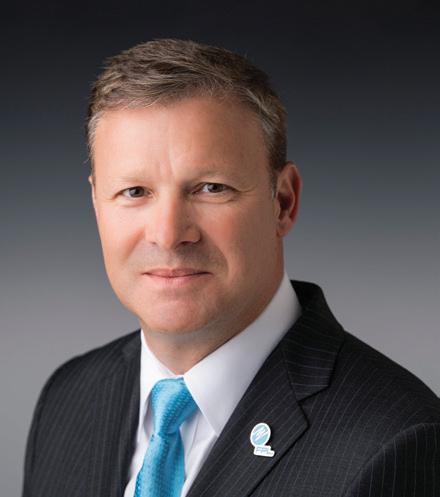
Indeed, FPL has set ambitious goals numerous times and managed to achieve them. In 2001, for example, it was the largest consumer of oil in the country. “That year we burned 41 million barrels of oil,” says Silagy. But the company grew uncom fortable with the volatility of oil prices, as well as the fact that they were importing oil from countries who were not allies of the U.S. They began by modernizing or replacing decades-old plants in order to move to natural gas—though not without a challenge. “We had many, many detractors, groups representing industrial customers and retail customers opposed to tearing down the old plants for a variety of reasons,” says Silagy. “But we stayed the course.”
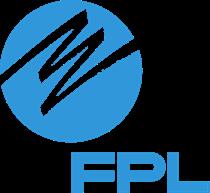
The result? A 99 percent reduction in oil consumption. “Does that change the world? I don’t know—but it’s $4 billion or $5 billion a year in fuel that we’re no longer sending to countries that aren’t always friendly to us.”
Plus, the more efficient power plants have allowed the company to pass on some $12 billion in savings to customers. “We’ve been able to generate the same amount of electricity, but using less fuel.”
In 2019, FPL again made headlines, announcing it would in stall 30 million solar panels by 2030. “We are five years ahead of schedule,” says Silagy, “and not a single project has been over budget.”

Now that FPL has gone through this process and made the investments in green technology—including around $7 billion annually for the last six years, all while keeping customers’ bills
well below the national average for more than a decade—they are in a position to help other companies figure out how to cut dependency on oil and improve energy efficiency, says Silagy. “We bring to our customers that kind of spirit of innovation and determination, and the track re cord of being able to figure out how to get there.”
Being located in a state that boasts a similar can-do spir it has been a big help. “We’ve got a very constructive regu latory environment here,” says Silagy. “Our permitting system is designed to help people get things done. It doesn’t start with ‘No, no and no’—it starts with ‘Wow, that’s hard. Okay, how do we get it done?’”
“It’s not easy, but we have visibility into how we’re going to get there because of our experi ence, particularly in migrating off fossil fuels to cleaner fuels, as well as with renewables.”
Like FPL, Florida has been mo tivated by economic reasons to focus on environmental issues. With one in eight jobs tied to tourism and 127 million people vis iting Florida each year—making it the No. 1 tourist destination in the world—keeping the beaches pristine is critical. “It’s the right thing to do for future generations, but it’s also just really good business,” says Silagy, who notes that the state has worked to make sure that environmental strategies are affordable. “If it’s not afford able, it won’t be politically sustainable.”
The Sunshine State also offers a slew of other advantages to business, including economies of scale, multilingualism, low cor porate taxes, no state income tax, and a higher education system that has been ranked No. 1 in America by U.S. News & World Report for the last five years. And at a time when companies are strug gling to attract talent, being able to offer access to mild weather year-round is a bonus, says Silagy. “If you like the outdoors, this is a really great place to live.”
—Eric Silagy, Chairman and Chief Executive Officer, FPL
CEOs HAVE SPENT THE LAST FEW YEARS chasing suppliers, employees, price increases, digital transfor mation, health protocols and new customers. But that to-do list left out one crucial priority: existing custom ers. And now, amid a groggy economy, more companies are pivoting toward a concern that may be the most important of all.
Their intent is clear: 41 percent of CEOs polled by Chief Executive in July cited “shifting focus to consum er retention” as an action they had taken or consid ered taking over the previous three months, making it far and away their biggest expressed priority. “Speeding up automation/digital transformation” registered second, with 32 percent.
“The last couple of years were pretty good for busi ness in the rebalancing after Covid, unless you were in commercial real estate,” says Stacy Kemp, executive lead of Deloitte’s CMO program. “But now, as things begin to contract, you’re finding that competitors are pursuing customers who are sitting on the edge of their loyalty.”
The classic formula holds that acquiring a cus tomer costs up to six or eight times the outlay for retaining an existing one. Customers already in hand spend about 30 percent more and are about 50 per cent more likely to try new or adjacent products and services than new customers, according to Deloitte. “Ten or 20 or 40 strategic accounts drive 80 percent of revenues for most organizations,” says Dave Irwin, president of Polaris I/O, a B2B customer-retention software platform.
Current business customers don’t need to be vetted, “so they’re an easier path to growth during tough
times,” Irwin notes. And on the consumer side, digital technology via apps and loyalty programs has made it immensely easier for companies to engage—or reengage—existing customers.
Many companies slipped on retention efforts over the last few years. The apple-cart upset of the economy by the pandemic unmoored countless prior customer relationships, blew up traditional reten tion strategies such as business travel, and served to commoditize entire industries online. More than half of consumers surveyed by Accenture now say that company and brand names aren’t as important to them as they used to be.
But consider the premium-dog-food business for an example of the effectiveness of customer reten tion. Pet ownership boomed during Covid, and most Americans have kept their furry friends. New York City-based PetPlate helps hold on to purchasers by humanizing pet relationships with a “close-up of the month” testimonial about its subscription-based, high-grade products.
For Better Choice, another pet-food maker, the key to retention is strong handholding online and on the phone via email and text messages and continual promotional offers. “If you get them into the brand and they never hear from you, potentially they’re likely to switch,” says Scott Lerner, CEO of the Tampa-based provider of Halo brand dog food. “But if your product performs and they hear from you on a fairly consistent basis, they’ll stay with you over time.”
Some ways for CEOs and CMOs to regroup around customer retention:
Leverage data. Software and data platforms allow
It may not be as sexy as winning new business, but in this economy, it’s even more critical. CEOs share strategies.
“movement away from large global and national solutions to micro and curated experiences, mixing products, services and content, and being deliv ered at a much more regional, local and individual level,” Kemp says. “And harness all the third-party data out there to almost predict what customers are going to need before they need it.”
Then respond to those signals. “If a white paper by marketing has never been sent to this customer, you can send it, boosting the relationship,” says David Keane, CEO of software provider Bigtincan.


Work with champions. In the B2B world, sup pliers often enjoy “champions” inside companies. These days, “our champions are looking for infor mation to defend the value the customer is getting,” says Mark McClain, CEO of provider SailPoint. “In our case, it’s security and efficiency. These champi ons now want us to come along behind them and show that value.”
Adopt the customer’s perspective. “Custom ers are looking for vendors and suppliers who can help them solve their problems,” Irwin says. “They don’t care about your product; they care about who can align to solve their problems, and they’ll spend money on that vendor.”
Knock, for example, created a customer-advi sory board made up of buyers of its rental-hous ing management software. “We rotate through our best customers and get an idea of their needs and whether we’re hitting the mark and [needs that are] up-and-coming,” says Jennifer Haas, chief revenue officer of the Seattle-based outfit. “So we’re constantly getting the pulse on what customers want.”

Assume evolving needs. About two-thirds of consumers expect companies to address their changing needs in new ways, up from about half a year ago, according to Accenture. “Business leaders must focus on transitioning from a cus tomer-centric to a life-centric approach, making connections between consumers’ ever-changing needs and environmental and social influences,” says Rachel Barton, lead of Accenture Strategy’s business in Europe.
Here’s how a dozen company leaders are priori tizing customer retention.
Harness all the third-party data out there to almost predict what customers are going to need before they need it.”
—Stacy Kemp, Deloitte Customers are looking for vendors and suppliers who can help them solve their problems.”
—Dave Irwin, Polaris I/O
If your product performs and they hear from you on a fairly consistent basis, they’ll stay with you over time.”
—Scott Lerner, Better ChoiceFAST-FOOD PROVIDER KEEP IT SIMPLE Brian Niccol, CEO | Chipotle Newport Beach, California



One thing we’ve heard is that our customers would like some menu variety. But the best way for us to keep customers is that, 80 percent of the time, they’re going to order the same thing.
So we have to make sure the rice is great, the beans are great, the chicken is great, that every day the menu is terrific and that we do the best job of building the bowl the customer wants, with good speed. You can’t skip by that.
And then, to keep people engaged and the menu relevant in our culture, we can do two to three new menu things a year without screwing up the front line and our menu. We make sure those two or three items are things we can truly execute without dam aging our core business or negatively impacting it.
Recently, we had a brisket variety and cauliflower rice, and they were good. We’ll probably do one other menu item this year. Think of us as a restaurant that does seasonal changes. We’re not in the limit ed-time-offering business.
In today’s world, you need to have relationships and regular communication, even if it’s more virtual now than in the past. These relationships are especial ly difficult right now because of supply-chain issues. Delays and lead times have driven our cus tomers to place orders a lot larger, and a lot farther in advance.
So we ask: Are these orders something you want or something you need? It’s one thing if you’re mov ing your orders around because you’re afraid we won’t deliver in a timely manner. But it’s a different issue if you really need it to keep your production lines running.
We stay on top of this by adding time from our customer-service staff in communicating, and we’re putting a lot more calls on the shoulders of account managers. Instead of every one or two weeks, they’re literally on the phone every day trying to get a sense of and feel for what customers need.
And with hyperinflation, we also need to communi cate our price changes: Some customers think that if they place an order today, it locks up the price for the next 12 to 18 months of lead time. But, sorry, that’s not the way it works in today’s world.
PROVIDER OF SUPPLY-CHAIN SOFTWARE GET THINGS RIGHT Duncan Angove, CEO | Blue Yonder, Scottsdale, ArizonaWe’re very fortunate, because we do something incredibly important: When your ware house is down for an hour, we give you a call. So all of our relationships are with the CEO. When something goes wrong, everyone knows about it. And you’re only as good as your last reference.
But we get the product right, and we empower our associates. We actually understand how companies can drive a 50 percent reduction in inventory and increase customer service by 15 percent. It’s core to what we do. So when we engage, we are literally having a business-level discussion around the metrics they’re trying to drive. It’s not just, “How did the project go?”
Our retention philosophy is getting the product right in the first place. We architect the product roadmap from the customer’s income statement, back. We ask, what are the things we can add to our product that move those dials? If we create more value for the customer than the competition, everything else will take care of itself.
Alyssa Phillips, COO | HCR Wealth Advisors, Los Angeles

Client expectations have changed very dramatically over the last 10 years, so the type of service offering that was considered above average is now table stakes with the very dramatic advancement of fintech. We need to meet the level of transparency that customers are seeing in the rest of their lives. We blame those expectations on Bezos and Amazon.
Having subject matter experts to build out the technology for that has been cru cial for us. We must have some vertical infrastructure in place to keep up with these demands and set ourselves up for future growth.
We track in our CRM platform, and we have had an uptick in the number of con versations we are having and increasing the share of wallet to take advantage of low-hanging fruit, and increasing our share of assets of our clients.
It’s not just the RV that keeps our owners loyal and coming back, but the entire experience we surround them with. For those who’ve spent at least $500,000, for instance, we have a VIP Delivery Experience that gives owners unparalleled attention over two, three or four days. They personally receive their coach once it comes off the line, and then we pair them with a product specialist who walks them through every element of their RV. It’s a $10,000 add-on option.
And the Platinum Experience for them adds a dedi cated team to answer questions, 24/7 support covering roadside assistance, a program we call Platinum Warranty Protection, an exclusive app, and access to Freightliner Elite Support for nationwide chassis repair and service.
We also have had an owner council since the be ginning. Right now, the American Coach Association has more than 700 members, and they’re a tight-knit group who often travel together and attend yearly owner rallies.
Plus we listen to our owners and respond to their needs. That’s one reason we introduced some shorter floor plans in 2021. We know most owners aren’t travel ing the country for 12 months straight; instead, they’re leaving a home base and going to a resort in Florida or Arizona. So our new American Dream 39RK gives them more of the amenities of home, like in the kitchen.


In our business, customer success can be about playing defense more than offense. But we’ve flipped it and really trained ourselves to be proactive. If you were in CX, your role used to be to put out fires when they came up and get renewal every one or two or three years. But now we are more proactive, with lots of interconnected and reinforcing steps in train ing, organization, hiring and scorekeeping.
So with our customers, we now have a periodic touch through a monthly check-in or quarterly business review. That’s where the game gets played. We’ve changed the agenda or content of that session from one of, “What can we do for you, Mr. Customer? What’s on your list?” to where we’re saying, “Here’s what we’re seeing in how your people are inter acting with your Igloo,” and what they should think about, given that.
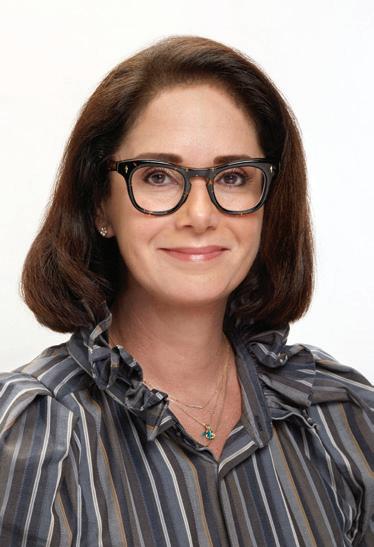
We provide writing and organizational products, and we’ve just celebrated our 35th anniversary. The company was founded on the idea that no sale is more important than a single customer. If you treat them the right way, they will stick with you.
There have been chapters in our history when we didn’t do that. Our customer service used to be out sourced, and it was a horrific experience. I brought it back when I came to the company a few years ago. We are no longer are open 24/7 for that, but custom ers are fine with that. The most important thing was not handing off that experience to someone else.
When we closed our last retail stores, we sent a handwritten card from me to our retail-only custom ers with a special offer. We managed to save a bunch of customers.
And in our regular BizRate surveys of custom ers we’ve begun asking if they have new-product ideas. One of our newest products, the carousel bookcase, came out of a customer request almost two years ago.
People are more willing to relocate with the work-fromhome phenomenon. The home is the largest investment people typically make in their lifetimes, so if we do it the right way, we have a customer for life, and we get referrals and repeat business; if you do it the wrong way, it will haunt you and your brand forever, especially with the internet. About a quarter of our buyers are referrals from one of our homeowners.
We build custom homes, not spec homes. So it’s important to communicate with customers about their expectations and build the right relationship. Every week our local team contacts every customer, and we empower our teams to make real-time deci sions on the ground, no expense spared. We have to do what’s right for the customer.
And we keep in mind that about 60 percent to 70 per cent of transactions involve a Realtor. We have to take care of that third party so they’ll stand up for us, and we build a referral base in that community. We can’t give them referral gifts, but we can ask for referrals.
Dennis Maple, Chairman and CEO | Goddard Systems, King of Prussia, Pennsylvania


We operate 595 franchised schools in 37 states, and we’ve had double-digit increases in enrollment, with 45 percent of our schools having wait lists. So we have satisfied customers, and, more important, they are advocates. Our local owners have to repopulate their rooms with pre-K classes every year.
So during Covid, we helped parents think through ideas for that peri od, and the stresses on them and children, with a series we put online called “Parenting Under Fire.” We also quickly came up with an online curriculum called “Goddard on the Go” for parents during Covid.
We have an educational advisory board. We went on a media tour with it. The first year, it was all about what to expect when you return to school in the fall of 2020. We’ve repeated the media tour for the next two years. It has received 28 million hits.
We work with our local owners on the safety and care of kids, which parents are especially concerned about. For instance, the owners themselves greet parents in the morning and afternoon at the front of the building, so parents can see the smiling face in charge of and responsible for their children.
Bahama Buck’s vision for the future is also the foundation of a thriving company culture.



A KINDNESS-FIRST CULTURE with core values emphasizing its secret ingredients being flavorful, friendly and fun, Bahama Buck’s created more than a trademarked Cup of Sno. In 1990, owners Blake and Kippi Buchanan opened their first shaved ice shack with a vision for the future: to provide the Ultimate Tropical Dessert Ex perience. More than three decades and a few tons of ice later, the company’s culture, which serves as a stabilizer for its continued growth, remains consistent.
We sat down with Kippi to discuss the practice of establishing a long-lasting company culture.
LEDA: Tell us about the culture of Bahama Buck’s. KB: The first thing that we tell our Avalanche Crews and our staff is that we want to be flavorful, friendly and fun. I mean, that really is our vibe. And we want that not only in our corporate office, not only in our warehouse, but also in our shops with boots on the ground. Our goal is to bless, refresh and create a mini vacation for our guests.
Really, it’s that simple, but also, I think the biggest piece of culture is how you treat people. That starts from the top, and if the owners are kind and create a culture that is centered around our values and blessing our guests, it will be reflected in the experience we provide, not only to the people who come into our office but to every guest who visits our shops. We make decisions based on the question, ‘Does this Bless Our Guest?’ If we remember what drives us, what is our why, then we’re always going to have a great culture.
kind way?” Unkindness is not tolerated within our office.
Your teams in the shops and in the office are tightly knit, and all have a great rapport with one another. How do you maintain that?
I try hard to pour into all managers within our franchise system while they are here in Lubbock for training. However, the shop will always reflect the owner or owners’ vibe. If the owner has a stingy heart, that shop reflects a stingy heart. If the owner is kind, friendly, flavorful and fun, that energy will be reflected within the shop. I believe leadership is influence. Leadership is an example. Those are the two most powerful tools that a leader has. How you do things is how they will do things. More is caught than taught, always. So, you do have to mop the floor every once in a while; it doesn’t mean you have to do it all the time. It is crucial for your crew to see you are going to be right there beside them.
I just recently had all our Lubbock managers over to my house for dinner. I genuinely care about my managers, and if I can pour into them and tell them that I love them and that I care about them not only as individual people but as our management team, they’re going to replicate that down the line.
How has your company’s culture evolved since its inception? I like this question, because it’s kind of like, to me, our corporate team is like a body, and the culture—the soul—will never change. I may age, but my values are always the same. We have to continue to grow. We can’t ring up things the way we used to ring them up on a POS or fax things over, it’s all on an app now. So, we have to evolve in those areas and advance the brand in that way. But the values? Those can’t change. Our company must evolve to grow, but the core of who we are, our soul, stays the same.
How have you established your culture to be what it is today?
I think this starts with the leadership. I’m a firm believer in pro moting from within. When it comes to our shops, I want to give a 16-year-old a pathway for growth. It’s rare for us to hire a manager from outside of the company to come in and manage this team. Why would I not choose someone who has already grown from a newbie all the way up the ranks to be a manager? The respect is already there. I believe this creates a great culture, because our team members and our managers have years of experience with in our company, which means they have bought into the culture.
I also think how we respect one another is very important. Conflict in a corporate office is something that can’t be avoided, but how do we treat each other when we have conflict? Do we speak respectfully to each other, or is it ugly? How we want our teams to work starts from the top. We ask ourselves, “How can we grow our brand, create new ideas and resolve conflict in a very professional,
What are you most proud of with the culture you have created?
It’s the people for sure. My managers aren’t going to stay at Baha ma Buck’s forever, I know that. But when you go out and you see an Avalanche Crew member or manager who moves on and does great things, you can’t help but be so proud. My fondest memories are hearing how much that first job meant to them and what they learned. To me, this whole thing is about how we have impacted the lives of our people or influenced their decisions. We get a front-row seat to watching them grow. We do have an influence on people. And I just hope that we leave a good influence on people’s hearts and minds.

We rent homes that also have the components of resorts, with amenities, services and brand standards. Most people expect to come to a house and be on their own, but we make them feel like family. They may be used to going to an address and seeing a lock box, but instead we have a local “front desk” where they check in and are welcomed warmly. We go to the site with them, help with their luggage, tour the house—take it to a level they don’t expect.
We capture data on them verbally and online. So maybe they have a dining pref erence or a type of pillow they like. We also know what kind of marketing they engage in, such as photos or texts, and we can create a 360-degree profile of the customer. Instead of giving everyone the same advertisement or experience when they come onto the site, we can customize the experience. And you don’t have to ask.
We also are rolling out a loyalty app that goes way beyond most travel apps, which people look at only two or three times a year. We tie it to some of the biggest transactions in life, such as buying a car or a house, with benefits for those kinds of purchases. People can gain points through dining and entertain ment and shopping venues with our partners and then get points in our loyalty program to maybe offset part of a down payment on a house. You’re doing normal transactions in life and getting credit for them.

About 80 percent of our weekly shipments are repeat customers. That only works if you don’t have a leaky bucket, and we’re working hard to make sure we don’t. So we make sure they have a great customer experience and a really outstand ing product.
We’re also very data-centric. It’s kind of a simple way of viewing the world: How much do I pay Facebook and Google to acquire this customer, and then how many are coming in on a weekly basis? We group those as a cohort and look at their ordering patterns over time. We have a ratio for what we pay to acquire customers versus net revenues after discounts; what do we get as a profit for those user bases?

About one-third of our revenues come from repeating customers, but the oppor tunity is there to get to much higher numbers. It will become more expensive to get new customers in the next few years, so we need to dedicate more resources to giving them a reason to come back.
That’s by focusing on value, not price; everyone can be lower-price. You don’t get customers to come back just by being low-price but by delivering an experience that aligns with their needs. So we do more consumer surveys than ever before to understand their priorities and needs and aspirations.
We also have completely reprioritized our technology road map around customer-centric initiatives. Historically, when we were in a pure-offense mode, we had a lot of projects on the roadmap that were nice or must-have. What we’re doing now and for the next few years at least is that anything that’s customer-centric or better for the customer takes priority over what’s better financially for the company.

At Nasdaq, we applaud the success of organizations. under the leadership of CEOs like Marc Benioff, championing growth and setting the pace for tomorrow.
Congratulations to Salesforce’s Marc Benioff on being named the 2022 CEO of the Year. www.nasdaq.com

“We haven’t done an acquisition in two years because of Covid and the focus on our internal technology transformation, but I’m feeling very bullish about M&A at the moment.” —Kate Duchene, CEO, RGP
OVER THE LAST TWO YEARS, Josh Rogers, CEO at data integrity solutions provider Precisely, completed seven acquisitions. So did CEO BJ Schaknowski at healthcare operations software and services provider Symplyr. Not that it’s a race, but Robert DiPietro pulled off six acquisitions in the past year as the CEO at Air Pros USA, a fast-growing HVAC repair and installation business in seven states.
The midsize companies’ recent acquisition splurge tempered a bit in Q2 2022, but the three chief executives are resolved to continue splurging, despite an economy that whipsaws in an average month from good news (another terrific jobs report) to bad news (persistent inflation, higher interest rates and recession fears).
“We’ve easily got 200 companies on our M&A heat map,” says Schaknowski. “We’ve done fewer deals in the last few months, since a lot of sellers were hoping their valua tions would come back to where they were six months ago. This hasn’t been the case, and we’re more engaged with them than we were before. I’m flying out tonight to meet with
In the reset to a buyer’s market, acquirers are (so far) shrugging off higher interest rates to nab the right opportunities. But while the game is much the same, the rules are definitely shifting. Here’s how to play.
the CEO of another large healthcare oper ations provider to talk up a deal.”
“Our M&A pipeline is very active,” Rog ers concurs. “We’re funding deals primar ily from cash flow, so higher debt capital is not much of an issue for us. We’re profit able, and the compa nies we’ve bought are profitable. The pace of dealmaking has not slowed.”
It hasn’t slowed at Air Pros USA either, which is on tap to acquire the same number of businesses transacted it did last year.
“Our sweet spot is around six to eight ac quisitions annually,” says DiPietro. “We’re not slowing down at all.”
Buy, buy, buy is the refrain echoing across medium-size companies, assuming they have steady cash flow, strong banking relationships and a compelling business proposition to entice sellers to the table.
Deals are predicated on producing bigger revenues, cost synergies and geographic market share, as well as to access needed skill sets, suppliers, intellectual property and technologies.
In the first half of 2022, the aggregate number of closed M&A deals in the U.S. fell 13 percent, and newly announced trans actions were down 31 percent, compared to the same period in 2021. But last year’s M&A activity was one of the highest wa termarks in recent memory, meaning this year’s figures are nothing to sneeze at.
“Mega-deals have slowed because of higher interest rates causing a tighter debt market and deeper regulatory scrutiny of deals, but we’re seeing a significant uptick in sub-billion-dollar deals,” says Joseph Radecki, corporate finance managing direc tor at audit and advisory firm KPMG. “The volume of M&A deals in the $500 million range and especially in the sub-$500 mil lion range is surprisingly resilient.”
Investment banker Gregory Bedrosian shares this perspective. “Our firm focuses on midmarket deals up to $1 billion,” says Bed rosian, CEO of global technology-focused investment bank Drake Star. “In that ecosys tem, we’re seeing privately held companies and portfolio-owned companies more active in M&A activity than large corporations, particularly in the technology, ecommerce, fintech and digital media spaces.”
He projects that this activity will continue through the balance of 2022 and into 2023. Radecki is reading the same tea leaves. “There is a healthy mix of entrepreneurial founder-owned private companies and also a good-sized block of private equity-backed and venture capital-backed businesses seeking an exit at attractive prices, especial ly for midsize companies looking to acquire in the technology, media, telecom, health care, payments and construction sectors,” he says.

Is it a buyer’s market? “Yes, in the sense that there are quality companies that are growing with healthy margins that are available to acquire, but not in the sense that buyers can come in and dictate the prices and terms to these entities,” Radecki says. “There’s still some competitive tension.”
Jay Langan, partner and national M&A industry leader for financial services at Deloitte & Touche, has a similar opinion. “It was a seller’s market last year, but there’s now some instability as to who is in con trol,” he says. “Certainly there are a lot of strategic and financial reasons for midsize buyers to be out there buying.”
One of those financial reasons is a buying price reflecting many sellers’ lower valua tions. “I interact with hundreds of clients and counterparties on a regular basis, and they are attesting to what they see as a great reset in valuations following the chill that froze many deals in the second quarter,” says Bedrosian.
He explains that once buyers realized the NASDAQ was down 30 percent, the Russia-Ukraine war wasn’t ending anytime soon, interest rates were headed upward and a recession was an actual possibility, “they stress-tested the target’s forecasted revenue and profitability, causing a lot of
“We’ve easily got 200 companies on our M&A heat map.”
—BJ Schaknowski, CEO, Symplr
Adequate due diligence into a target company’s opera tions, finances, people and technology, among other con siderations, is what separates a good deal from a lesser one. The challenge in a buyer’s M&A market is a tendency to rush the deal to a close before a competitor arrives with a better offer. Like the saying goes, speed kills.
More than half of all M&A combinations fail to achieve their intended goals, with a famous Harvard Business Review study in 2011 pegging the rate of failure between 70 percent and 90 percent. To be fair, stuff happens after a deal closes that no one can control (like an unexpected recession), but many trans actions come to tatters because not enough consider ation was given the target’s strategic fit.
These days, fit is a more complicated subject, says Gregory Bedrosian, CEO at global tech-focused invest ment bank Drake Star, which has completed 450 transac tions on the buy-and-sell side in the past nine years.
“The sectors the firm covers, like technology, digital media, fintech and telecom, are all heavily regulated and getting more so,” he says, pointing to recent SEC propos als to disclose ESG data like greenhouse gas emissions and human capital risks. “More time is needed in the due diligence period for buyers to deeply assess and stresstest the target’s forecast, much more than in the past, given newer risks like ESG that can affect the acquired company’s prospects.”
Jay Langan, a partner at Deloitte & Touche, where he is the national M&A industry leader for financial services, says several clients have “walked away from deals once they discerned the target company’s ESG profile, con cerned that it would make their ESG profile worse. Every company needs to improve their ESG metrics, and you don’t want to unroll what progress you’ve made because of someone else’s problems.”
Other consultants agree that ESG is gumming up a lot of deals. “We’re seeing it become a key consideration across the board for all buyers, especially among larg er acquirers,” says Joseph Radecki, corporate finance managing director at audit and advisory firm KPMG. “This doesn’t mean that targets have to have a fully im plemented, soup-to-nuts ESG program, but there does need to be evidence the company is thoughtful about its responsibilities to stakeholders like customers and employees.”
Due to the uncertain economic path ahead, Radecki also advises deeper due diligence into more traditional concerns. “If we find ourselves in a recession, which some people think already is underway, you need to know how the target company’s earnings forecast, operations and customers will react in a recessionary environment,” he says.
Another customary due diligence consideration, dis tilling the impact of a more rigorous regulatory agenda governing the combined organization, is also in scope, following the Biden administration’s abandonment of the long-held view that vertical mergers pose no com petitive threats.
“The possibility a mega-deal may not close due to regulators’ enhanced scrutiny is having a chilling effect [on some M&A transactions],” says Bedrosian. “For large deals to close, there needs to be a high certainty they actually will close.”
Otherwise, the costs of dealmaking—the fees paid external consultants, auditors and law firms, as well as the time squandered by senior executives in developing the offer and lining up the financing—are prohibitive, he ex plains. “If, at the end of the day, there’s a good possibility the deal will be quashed by regulators, you want to know this beforehand.”
transactions to be renegotiated over the summer with different ‘bells and whis tles,’” he says.
These new features included a flurry of earnout considerations, where the negoti ated purchase price was contingent on the acquired entity satisfying specific perfor mance goals for a period of time after the deal closing. The delayed payments haven’t stopped sellers from selling, a sign of con fidence in their business prospects ahead.
As Bedrosian sums up current midmarket dealmaking, “The summer months thawed the deep freeze.”
Depending on the industry sector, acqui sition opportunities seem there for the taking. “We haven’t done an acquisition in two years because of Covid and the focus on our internal technology transformation, but I’m feeling very bullish about M&A at the moment,” says Kate Duchene, CEO at global consulting firm RGP, a publicly traded com pany with more than 4,300 employees and $805 million in FY 2022 revenues.
These feelings are prompting Duchene to scout around for assets like technolo gy companies that were high-priced six
“Lots of small businesses are looking for an exit, with their owners nearing retirement, worried about the economy and looking to get out.”
—Robert DiPietro, CEO, Air Pros USA

months ago but are “no longer white hot,” she says. “I’m not looking for transfor mational deals per se; rather, I’m interested in tuck-in ac quisitions that expand areas of expertise we already have. For example, I’d like our tax consulting practice to be much bigger. There’s strong demand for these services, but we can’t build it organi cally fast enough.”
Having retooled RGP’s list of acquisition targets, Duchene and her CFO, Jennifer Ryu, are presently engaged in negotiating three deals. “I have a great CFO who presciently renegotiated our credit facility last year, in anticipation of us becoming more acquis itive this year,” she says, noting that RGP has the financial means to execute the three transactions without going to the financial markets.
Profitable cash flow is prompting other CEOs to plot possible strategic tuck-in acquisitions. At public company BlackLine ($424.7 million in 2021 revenues and more than 1,900 employees), CEO Marc Huffman sees M&A opportunities for midsize companies that are “well capitalized and have cash on the balance sheet,” he says.
Tuck-in acquisitions are in view at privately held healthcare payments and pricing company Zelis, with 1,700 employ ees and an estimated $1 billion in annual revenues. In August 2022, Zelis acquired Payer Compass, a provider of healthcare-re lated claims, administration and processing solutions. Another tuck-in acquisition, Sapphire Digital, a healthcare platform for provider selection, patient access and digi tal transparency, closed in 2021.
“We do M&A for long-term strategic value creation,” says CEO Amanda Eisel, a former consultant at Bain Capital and McKinsey & Company. “We’re very delib erate about the deals we do. This was the case with Sapphire Digital, as it had specific solutions in the healthcare space that were needed because of regulations coming into effect around price transparency. Either we needed to build this capability or buy. We bought.”
Eisel isn’t just focused on tuck-in acquisi tions. “Valuations have come down to earth a bit,” she explains. “There are some large players that were thinking about going public but are now rethinking it. I’m not averse to big transformational M&A deals. Potential downturns open minds to unique opportunities.”

“Valuations have come down to earth a bit.”
—Amanda Eisel, CEO, Zelis
BlackLine fits this profile. Over the past year and a half, the global provider of auto mation solutions for finance and accounting closed two strategic acquisitions, Rimilia and FourQ Systems, with cash. The tuck-in acquisi tions augmented BlackLine’s capabilities and competencies in accounts receivable automation and intercompany financial management solutions, respec tively. “With approximately $1 billion in cash on our balance sheet, we’ll continue to be opportunistic in our M&A strategy, canvassing the marketplace for potential acquisitions accretive to the portfolio and valued at a fair price point,” Huffman says.
Price is a big factor in the appetite to buy at BurgerFi, a rapidly expanding chain of 122 fast casual restaurants, 97 of them fran chised. Two years ago, BurgerFi merged into a SPAC, giving it access to the public markets to fuel the company’s growth strat egy. “It’s an opportune time in the restau rant sector to buy right now,” says Patrick Renna, president of BurgerFi, which also owns the Anthony’s Coal Fired Pizza & Wings chain of 61 restaurants and hopes to buy other established regional brands.
Brands may be willing to sell, given economic headwinds and the pandemic’s cataclysmic impact, which resulted in the shuttering of 90,000 restaurants nation wide. Renna explains, “There’s a lot of uncertainty in the market right now, with inflation, higher interest rates and talk of a recession [causing] anxiety for business owners, particularly those looking for an exit. In such cases, it might be better
 By Carole Streicher
By Carole Streicher
INCREASED COMPLEXITY IN M&A HAS CREATED NEW challenges for dealmakers. But business leaders can suc ceed by taking a systematic approach to addressing the additional challenges created by complexity.
Based on observations from KPMG deal professionals from around the world, we outline five practical moves companies can make immediately to improve their odds of success when undertaking a complex transaction. These moves emphasize enhanced ways of thinking and require shifts in mindset, ambition and execution. They are, however, not exhaustive; each transaction will require a tailored approach.
The ultimate payoff from complex deals is often strategic value—new opportunities or new ways of doing busi ness that build long-term value, transcending traditional synergies. The strategic goals of the transaction, therefore, must be clearly defined, widely supported and pursued methodically and relentlessly.
It starts with leaders from both the buyer and target establishing a combined vision around strategic value. This north star sets the stage for execution and should be translated into tangible goals and objectives for leader ship. Key individuals who bring elevated commercial and operational value to bear should be involved early on in this process. A cadence of effective strategic reviews that continuously “restate” the core elements of strategic value can keep executives and teams aligned across time.
Diligence should not be a check-the-box exercise to validate baseline assumptions. Deal teams need to stretch further in search of greater value. This requires harnessing the power of data analytics to unearth new opportunities. Diligence is also your opportunity to explore the art of what’s possible with target management. Buyers should proactively engage with their soon-to-be colleagues to gain new and deeper insights, validate key assumptions, build buy-in around strategic value and enlist the target management’s help to imagine and design the future. Meanwhile, ask yourself what you need to do to be the best owner of the new business.
The moment a complex deal is announced, the stakes couldn’t be higher. Risks are immediately elevated around customers, talent, suppliers and other key stakeholders. Complex deals demand a different approach to Day 1 readiness—one with greater purpose, intensity and speed. Sophisticated buyers use the sign-toclose window to protect business momentum, find and mitigate blind spots, continue to seek even higher synergy upside and accelerate tailored integration planning.
To increase the odds of success, sophisticated buyers also establish a small high-functioning team. This agile, highly bespoke team of six to eight people launches im mediately upon signing and is responsible for accelerating the pace and success of the transaction. Its mission is to move with the highest levels of focus, intent, speed and empowerment to protect and create value in line with the deal’s north star.
More than ever, the value of a target lies in the capabilities, energy and culture of its people. Losing talent can make it impossible to achieve the deal’s objective. Understand what positions and capabilities are most critical to success, current attrition rates by key employee group, time to fill open positions, sources of available labor and recruiting processes. Then create targeted incentives.
Buyers need to be transparent about their plans and present the target’s employees with a clear and compel ling value proposition that is connected to the strategic goals of the deal. Communicate the goals of the trans action, build trust and excitement, and enlist your new employees in your quest for strategic value. Then create a supportive, nurturing employee experience.
Buyers define synergy targets at the outset, but they shouldn’t stop there. Be alert to new opportunities and prepare to flex as markets, leadership and strategies evolve. Beware of backsliding: After the integration reaches key late-stage milestones and initial synergy targets have been achieved, don’t assume the gains will stick. Don’t lose sight of the north star.
Learn more in the latest KPMG report, Navigating Complex M&A: how to win in the age of the complex deal.
Carole Streicher is partner, US deal advisory and strategy leader at KPMG US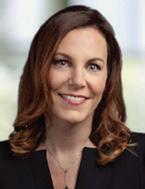
“There’s a lot of uncertainty in the market right now, with inflation, higher interest rates and talk of a recession causing anxiety for business owners.”
—Patrick Renna, President, BurgerFito sell the company than adapt to Covid, which changed the restaurant business model forever.”
He’s referring to capital expenditures in technologies providing digital point of sale, on-premises kiosk commerce and third-party delivery to customers, in addi tion to constructing outdoor dining spaces.
“At a time when the cost of capital is higher, now may be a good time to look for a buy er,” Renna says.
At Symplr, Precisely and Air Pros USA, the ink on one acquisition is barely dry before the contract is drawn up for another one. For example, Symplr ($500 million in revenues and nearly 2,000 employees) is growing at a near double-digit rate, engineering a presence in 90 percent of hospitals nationwide due in large part to its expanding capabilities.
data management, governance and compli ance, just a few of the hundreds of potential acquisitions on his heat map. “If caregivers can handle the administrative tasks more quickly, they have more time to provide quality care,” he says.

Rogers at data integrity solutions pro vider Precisely is similarly upbeat about closing additional deals on top of the seven acquisitions executed since May 2020, five in the last four quarters. “Softness in the valuations is making sellers more flexible on price,” the CEO says. “With the Fed rais ing rates, owners have open eyes.”
M&A targets include companies with capabilities in data integration, verification and cleansing, as well as location analyt ics. “Those are the four segments we’re focused on, and there is a pipeline of op portunities in these regards,” says Rogers, adding that in anticipation of executing ad ditional transactions in the months ahead, he’s created a dedicated corporate develop ment function focused on post-transaction integration.
Opportunities abound for Air Pros USA, given the HVAC industry’s “fragmentation,” says DiPietro. “Lots of small businesses are looking for an exit, with their owners nearing retirement, worried about the economy and looking to get out. We offer the opportunity to keep the business going to preserve their legacy.”
Having become a “known commodity,” many deals are non-brokered, emerging directly from the HVAC business owners, the CEO says. “From a size perspective, the acquisitions range from $5 million to $40 million in revenue, most of them funded through cash flow, although we do have a debt facility for the larger deals.”
Russ Banham is a Pulitzer-nominated business journalist and best-selling author.
These additional capabilities have been developed internally and through a spree of 11 acquisitions since 2018. The dealmaking isn’t over—far from it. Schaknowski says recent healthcare regulations on trans parency and physician credentialing have compelled a closer look at companies with competencies and technologies involving
With more than 700 employees and a three-year revenue growth of 3,392 percent, Air Pros is eying geographic expansion across the “smile” of the U.S., DiPietro says, from the mid-Atlantic seaboard down through Florida and across to Alabama and Texas, and then upward to the Pacific Northwest. “These regions are growing in population, resulting in high rates of new residential construction and home renova tions. They all need air conditioning.”
A new book from Ram Charan, best-selling author, teacher and world-renowned advisor to CEOs, and co-author Geri Willigan

Larry Bossidy, former chair and CEO of Honeywell, coauthor of bestseller Execution
“A must-read book for today’s CXOs.”
—RAJ RATNAKAR, SENIOR VICE PRESIDENT AND CHIEF STRATEGY OFFICER, DUPONT
“Insights to reinvent your own approach to this contemporary challenge.”
—Fred Hassan, Director, Warburg Pincus
INFLATION IS HERE. Will you take advantage of it?
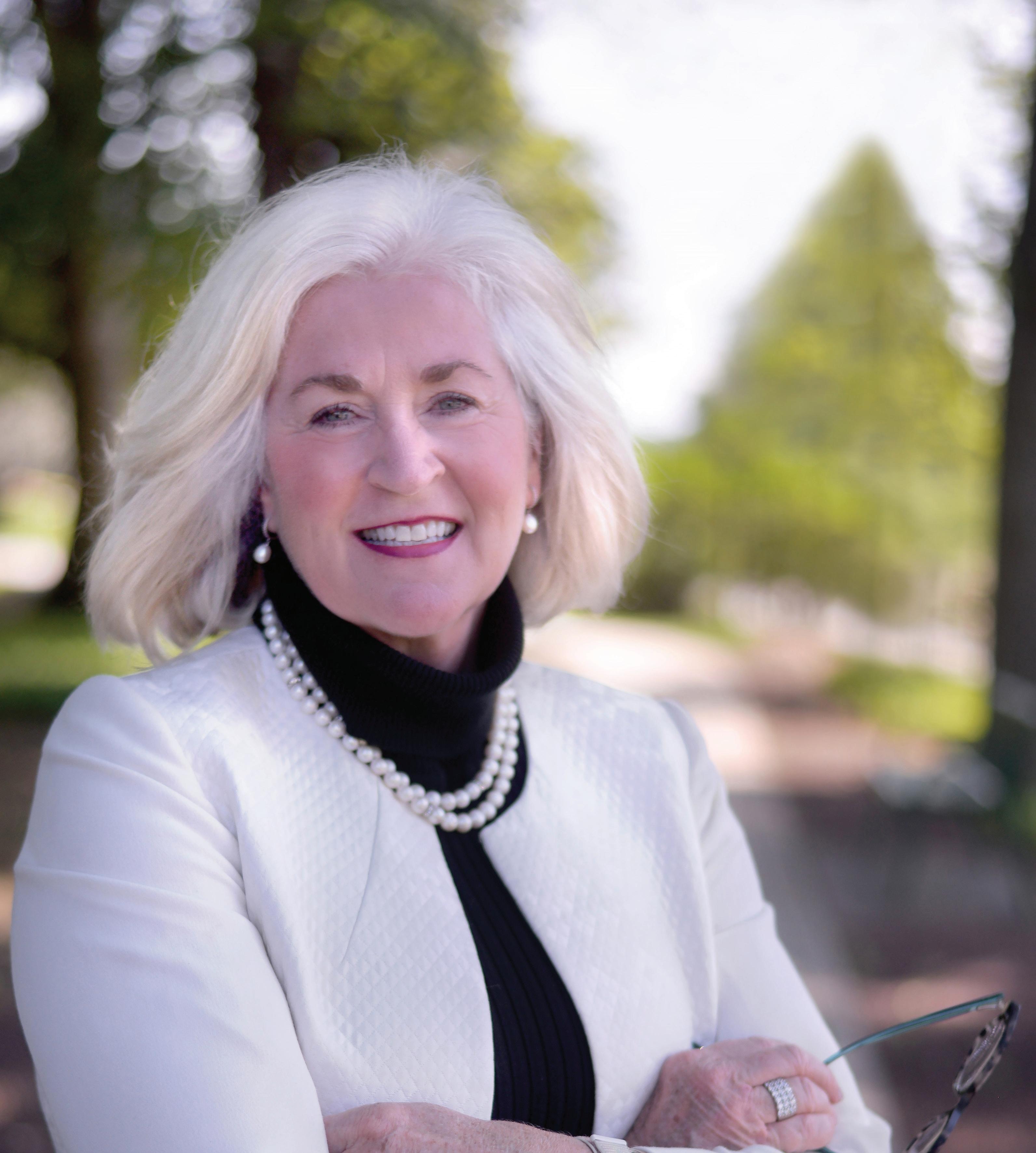

“Rita M. Gardner, President and CEO, proudly leads Melmark, one of the top 100 women-led businesses in Massachusetts.”




Thanks to its strategic initiatives, the Hoo sier State attracted a record $17 billion in committed capital investments in the first half of 2021, a 356 percent year-over-year increase. Secretary of Commerce Bradley
Chambers attributes this to solid invest ments driving growth and innovation in “future-focused” industries like semicon ductor fabrication and design, life sciences, Industry 4.0 and the innovation ecosystem.
In December 2021, Indiana rolled out an ambitious strategy in a plan called the 5Es.
It includes focusing on the Built Environ ment, building an Economy of the Future, leaning into Entrepreneurship, creating a plan to navigate Energy Transition and pro moting accomplishments through External Engagement.
In its 2021 annual report and 2022 strategic plan, Jobs Ohio, the state’s private nonprofit economic development corporation, noted 2021 as a landmark year with more than

29,000 jobs created and $6.9 billion in cap ital investment. Some top sectors included logistics and distribution, advanced manu facturing and information technology. These figures didn’t even factor in the landmark investment announced by Intel in January 2022, when the company said it would in vest up to $100 billion to build what could be the world’s largest chip-making complex in the state. “Intel has caught the attention of business leaders who didn’t consider choosing Ohio before this year, and we’re proving the state is a major competition for attracting new business tech, advanced manufacturing and other rapidly growing sectors that are looking to tap into our growing talent pool and strong business climate,” said JobsOhio President and CEO J.P. Nauseef in a press release.
In addition, Germany-based company Altenloh, Brinck & Co. announced a $23 million expansion in Bryan that will create more than 180 jobs. Universities in Ohio joined forces with others in Michigan and Indiana to form the Midwest Regional Network to Address National Needs in Semiconductor and Microelectronics.
The nation’s heartland is winning high-profile economic development projects, many in renewable energy and advanced manufacturing.
Intel made headlines when it announced plans to build the world’s largest chip-making complex in the state.
While agriculture has remained a primary driver of South Dakota’s economy, the state continues to attract a mixed bag of other projects. In January 2022, pet nutrition company Royal Canin announced a $185 million expansion and 149 new jobs at its facility in North Sioux City. Battery manu facturer Æsir Technologies announced in September 2021 that a new facility would be built in Rapid City with up to 400 new jobs in the first five years. In July 2021, tac tical accessory company Cole-Tax relocated to Rapid City from New Hampshire. Furni ture Mart USA also announced in June 2021 the doubling of its campus and corporate headquarters in Sioux Falls.
The state is still mainly on solid economic fundamentals. Its personal income growth led the nation in the first quarter of 2022, the unemployment rate is one of the lowest in the country, and it closed the 2022 bud get year with a $115 million surplus.
The Hawkeye State is growing as a nation al leader in the biofuel business. It now has 41 ethanol refineries and 11 biodiesel facilities, producing a respective 4.5 billion and 410 million gallons per year. Qore, a joint venture between Cargill and HELM, is investing more than $300 million to build the first renewable 1,4-butanediol (BDO) facility in Eddyville. This facility will pro duce QIRA, a next-generation BDO made by fermenting corn-based sugars. QIRA produces less greenhouse gas emissions, is more sustainable, and is used in spandex fibers, bioplastics and polyurethanes. The facility is on track to open in 2024. German
biofuel company VERBIO also selected Ne vada, Iowa, as the home base for its North American operations.
“Each of these projects exemplifies our economic development strategy in Iowa, which is about innovation and attract ing highly skilled jobs that will raise the standard of living and create wealth for our state,” said Debi Durham, executive director of the Iowa Economic Development Authority and Iowa Finance Authority.

From semiconductors and automobiles to EV battery manufacturing, recent announcements prove that Michigan is a place for businesses to grow, says Quentin Messer, CEO of the Michigan Economic Development Corporation. In FY 2021, the state announced nearly 14,000 new jobs and $3.7 billion in investments from com panies like GM, Ford and LG Energy Solution. As of August 2022, Michigan had already announced additional projects with commitments for 20,000 jobs and nearly $13 billion in private investment.
Messer attributes Mich igan’s success to increased funding and flexible workforce development training programs, partnerships to lower electric rates, shovel-ready sites and robust incen tives. “Over the past year, Michigan’s One Team approach has aggressively compet ed for and won economic development projects of all sizes in every corner of the state. We continue to drive a consistent and competitive state economic development strategy,” he said.
While the state remains a bedrock of the automotive industry, it continues to diversify and innovate in other sectors, like life sciences. Global Life Sciences recent ly announced a $430 million investment and 200 new jobs in Muskegon. Perrigo also chose Grand Rapids for its new North American corporate headquarters. Addi tionally, the state continues to be a hub for
GM’s electric battery lab is one of many projects automakers have undertaken in the state.
Meta plans to bring a one million-squarefoot data center to Kansas City.
Covid-19 vaccine manufacturing—Grand River Aseptic Manufacturing recently entered into an agreement with Johnson & Johnson.

The Show-Me state is preparing to deploy nearly half a billion dollars in recovery pro gramming to double down on its economic strengths, said Maggie Kost, acting director of the Missouri Department of Economic De velopment. She credits the healthy business climate in recent years to the two critical ingredients of workforce and infrastructure.
“We’re continuing to grow and improve our Missouri One Start workforce training division, and we’ve landed some very impressive projects in recent months,” she said.
Meta announced in March an $800 mil lion investment and
up to 100 jobs in Kansas City. This project and others are contributing to continued growth across industries, including trans portation and warehousing. The state’s 2.8 percent unemployment rate in August 2022 was the lowest since 1976 and well below the national average of 3.6 percent.
“We’re bolstering our economic climate with recovery programs around site devel opment, workforce training, community revitalization and broadband infrastructure developments,” said Kost.
The Sunflower State continues to grow its agriculture industry, and Gov. Laura Kelly recently cut the ribbon on North America’s largest wheat protein plant. Amber Wave, a leader in sustainable agriculture, food ingredients and low-carbon fuels invested more than $250 million in a facility in Phil lipsburg and created more than 60 jobs. Part of the decision hinged on the state’s location in the heart of the country, with
rail access to both coasts.
Outside of ag, there have been new devel opments in digital. Last year, the Internation al Division of the Kansas Department of Com merce embarked on a digital journey to create the Virtual International Marketing (VIM) program. The state recruited eight state com panies to talk about their digital strategies and opportunities for growth. In July 2022, cybersecurity company Novacase moved its headquarters from Santa Barbara, California, to Wichita. “More and more companies are choosing to come to our state because they’ve seen that our talented workforce, strong infrastructure and pro-business climate will help them grow and succeed,” said Kelly.
Big Sky Country continues to attract bigcity talent and companies in search of a laid-back rural life. In May 2022, Applied Materials, a world leader in materials engi neering solutions, opened a semiconductor manufacturing center in the Flathead Val ley that will create 200 new jobs. Hyundai Motor Group also announced it would locate its New Horizons Studio (NHS) head quarters in Bozeman to focus on developing Ultimate Mobility Vehicles (UMVs). The $20 million investment will create more than 50 jobs in Gallatin County.
John Suh, head of New Horizons Stu dio and vice president of Hyundai Motor Group, said the selection was based on the growing talent pool of skilled labor in engineering, research and natural science. “Bozeman is a thriving and economic micropolitan city. Nestled near dozens of off-road trails with more than 150 miles of terrain and mountain access for UMV testing—it’s the perfect fit for our new R&D lab,” said Suh.
Over the past year, the Cornhusker State’s agriculture industry set all-time highs for beef exports and corn and soybean pro duction, while manufacturing employment reached an all-time high in 2008. The
Dreaming. Innovating. Growing. It's how Michigan talent is making an impact on the world in key industries. From tech to mobility to advanced manufacturing, there's a different kind of hustle here. Expand your business in Michigan and get access to support, camaraderie and new opportunities.
Make the move at michiganbusiness.org/pure-opportunity
 Co-Founder & General Manager, Duo Security at Cisco
Co-Founder & General Manager, Duo Security at Cisco
Aerospace and defense is the state’s fastestgrowing sector.

growth has pushed state revenues more than $1.4 billion above forecast, putting Nebraska back on a track of unprecedented financial strength, said Gov. Pete Ricketts in a press release. “Additionally, the historic tax cuts we passed this spring are helping Nebraska’s businesses invest in their people, expand their operations and grow their communi ties,” he said.
Nebraska also continues to attract a growing number of venture capitalists and startup companies. 2021 was a record year for Nebraska startups who closed on more than $300 million in funding for 40 deals, making more than $1 billion in venture capital the state raised in the past decade, according to Invest Nebraska.
Home to leading power storage brands Rayo vac and Generac, Wisconsin has seen battery technology become a hot sector in recent years. The state is now doubling down on developing the latest lithium-ion technology through the Qualified New Business Venture (QNBV) program, which encourages invest ment in technology-based businesses with an income tax credit equal to 25 percent of the value of the investment.
One company, Conovate, is already taking advantage of QNBV by making new carbon-based material for lithium-ion batteries and is targeting it for use in power tools, electric bikes and drones. Founded in 2007 by UW-Madison chemistry professors, Silatronix makes a patented compound that improves the runtime of lithium batteries.
Additionally, Blue Line Battery manufac tures lithium-ion batteries specifically for forklifts. “We wouldn’t have made it to prof itability without capital, and we wouldn’t have gotten capital if it weren’t for QNBV,” said Phil Fonfara, president of Blue Line Battery. “If we didn’t have QNBV, we likely would not have received funding, and our business would not exist. It’s that linear.”
Staying open during the pandemic and moving forward has helped Oklahoma raise its GDP beyond 2019 levels and create surplus fiscal budgets, enabling it to save for the future while investing in new core programs. Aerospace and defense is cur rently the fastest-growing sector, says Brent Kisling, executive director at the Oklahoma Department of Commerce. The state has focused on a comprehensive strategic plan to maximize its internal supply chain of maintenance, repair and overhaul services. Oklahoma is home to Tinker Air Force Base, the largest Department of Defense Air Depot and the world’s largest MRO facility. While the infrastructure is attractive, Kisling also credits the state’s pro-business policies.
“We also set ourselves apart by the ways we work with businesses to find solutions,” he said. “In the past year, Oklahoma has taken significant steps to support busi nesses in a challenging and ever-changing global marketplace.”
In the first half of 2022, the state saw more than $2 billion in capital investment in aerospace, agribusiness, IT, manufactur ing and logistics. U.S. Rare Earth invested $100 million in a manufacturing facility in Stillwater, and Air Transport Components is establishing a new MRO facility in Tulsa. Additionally, Woodside Energy is plan ning a green hydrogen facility in Ardmore, which will add to the state’s already impres sive renewables sector.
The Peace Garden State continues to hit new milestones in economic development.
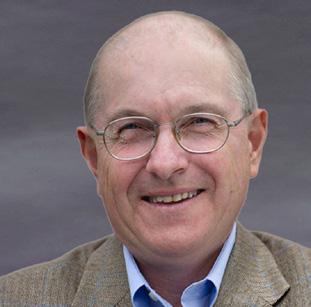

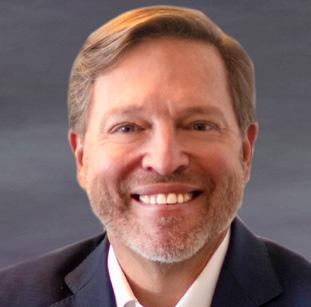
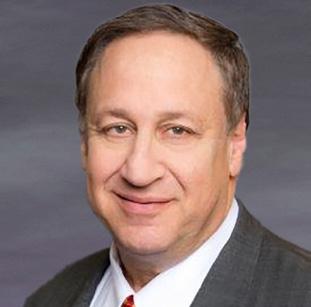
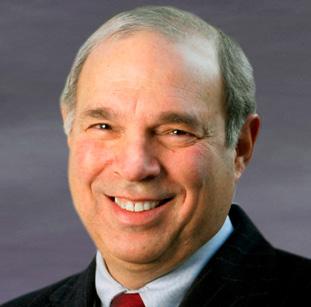
EV car maker
Rivian revitalized Normal, Illinois by buying a facility abandoned by Mitsubishi.
The Red Trail Energy LLC ethanol facility near Richardton, North Dakota, which in 2018 became the first state to obtain regu latory authority from the EPA over Class VI underground storage wells, started oper ations in July. In July 2022, Bitzero Block chain announced it would acquire and re develop the Stanley R. Mickelsen Safeguard Complex in Bismarck to develop it into a highly secure data center for high-perfor mance computing and data processing. The $500 million investment combines the two main state pillars of energy and agriculture.
North Dakota also recently expanded a partnership with the Cisco Networking Academy, a skills-to-job program that offers mobile, self-paced online learning aligned to industry jobs. North Dakota is the first state to make these courses available at no cost to residents. Courses and industry certifications include cybersecurity, coding, IoT and other technology focuses. “This statewide program will greatly benefit the people of North Dakota by providing opportunities to acquire best-in-class skills in highly sought-after, in-demand and growing professions,” said Gov. Doug Burgum. “Skills for All provides North Dakota residents from all backgrounds and experiences the opportunity to obtain 21st-century skills and help our state build a strong and competitive workforce.”
Early in 2021, 16 groups from Minnesota and the Greater MSP Partnership launched MBOLD, a coalition of food and agriculture companies striving to address the sector’s challenges. One of the goals is to develop
a circular economy for flexible film pack aging, improved soil health, water stew ardship and innovation. MBOLD recently announced a new cohort for its entrepre neurship program in June 2022.
Like many states, Minnesota’s strong rebound had now led to a labor shortage. Job openings in the state climbed to a record high of 214,000 in Q4 2021. The Department of Employment and Economic Development (DEED) kicked off the “Summer of Jobs” cam paign in June to highlight available jobs and opportunities in manufacturing, healthcare and technology. The campaign also shares best practices for employers to find workers in overlooked communities like immigrants, peo ple with disabilities and those released from correctional facilities. “This unprecedented number of job openings is another sign that Minnesota’s economy is strong,” said DEED Commissioner Steve Grove.
The Prairie State continues to attract new investments, landing 480 projects in 2021 that accounted for 21,000 jobs and more than $3.5 billion in capital. “Be in Illinois,” a new multimedia campaign launched this year, showcases the state’s assets, workforce and central location. “Illinois has a great story to tell, with a proven track record of innovation and success, but we have been shy about telling it,” said Dan Seals, CEO of Intersect Illinois. “As we survey a business landscape that values innovation, sustain ability and talent, it’s time to promote what we bring to the table.”
One exciting area of growth is the electric vehicle industry. Automotive technology company Rivian, whose presence in the state goes back to 2016, rolled its first truck off the manufacturing line last year. In 2021, the state also passed the Reimagining Electric Vehicles Act, which provides incentives in the industry, such as income tax credits. There have been other notable announcements as well. In Au gust 2022, Tyson announced a $180 million investment and 250 new jobs at a facility in Caseyville. GAF, America’s largest roofing manufacturer, announced an $80 million facility in Peru. CE



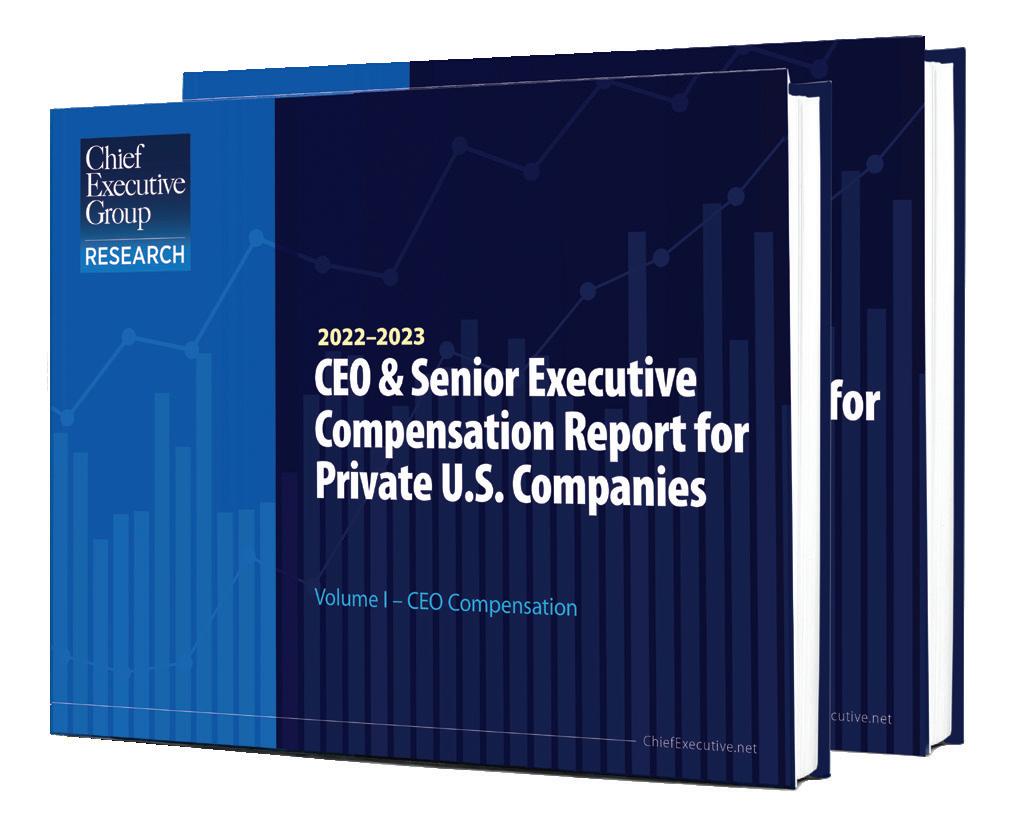











CEOs, CHROs and other company leaders from across America gathered virtually this fall for the CEO Talent Summit conducted by Chief Executive Group.
Even amid the slowdown of an economy struggling with inflation, continued supplychain difficulties, a bearish stock market, record-steep hikes in interest rates and anxiety over geopolitics, the theme was clear: Companies are still doing everything they can to add and keep great talent, and they need help in doing so.
Here are highlights of what they heard.
BY DALE BUSSWHEN HE WAS CHAIRMAN and CEO of Medtronic, the big medical-equipment supplier, Bill George became known for leading in a transformative way that was emulated by many leaders of the boomer generation.
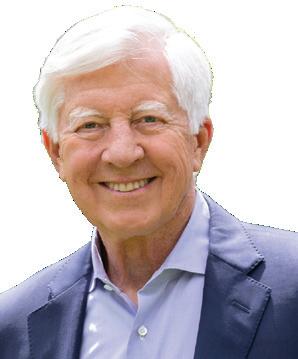
Now, as coauthor of his updated book, True North, George has some ideas for today’s business chiefs as they contemplate how to lead new gener ations of workers—and in many cases, leaders who themselves are members of the millennial cohort that is ascending to the top of the leadership pyramid in American business and society.
“We’re going through a massive leadership transformation,” George told the Chief Executive summit. “Boomers have been in charge for the last 30 years, largely with a command-and-control focus on primacy. Things are changing dramatically now [and there’s] an opportunity for a new genera tion to step up to all the top roles.”
Empathy, a values base and authenticity are the winning characteristics of the new generation of leadership, he said. “If you want to be a great leader now, you need to integrate brainpower and analytical skills with heart and qualities like compassion, passion for work and the courage to make bold decisions—and also have empathy. You can’t just be the smart est person in the room.”
George urged leaders to adopt “servant leadership,” a leadership philos ophy that has been gaining traction. “You work with people individually and spend a lot of time, get to know them and their hopes and dreams, and see if you can find alignment between an individual’s purpose and the compa ny’s purpose and values,” he said. “There are many worthwhile purposes in organizations that can bring them together.”
He expressed little patience for the “quiet quitting” that seems to be a new approach for disgruntled workers. “It’s a terrible idea,” George said. “If you hate your work, quit. If you hate your supererior, find someone else in the company to work for.”
And company leaders should facilitate that approach from the top down. “Top management has tolerated self-interested people,” George said, “and we need to get them out.”
COMPANIES CAN now gather, mas sage and analyze data for greater advantage than ever in recruiting and managing talent, retaining employees and assisting them in their journeys within the corporation—or even their career paths outside of it.
“HR should be run with the same discipline and rigor as any other business group,” Samantha Hammock, executive vice president and chief human re sources officer for Verizon, told the summit. “Our mission is to attract the right talent for our future, develop them to their full potential and inspire them to build a career at Verizon.”
In fact, the telecommunications giant has been transform ing its approach to make human resources “a data-driven function to deliver for the business,” she said. “It has evolved more than many other functions have.”
Here’s how Hammock said she and Verizon have been going about the transformation.
1) Create a master plan. “Getting HR on an annual operating plan is key, about what your team is doing from the top down,” she said. “You need to get that really succinct and calibrated [toward] evolving business needs. And make it clear.” Adopting a longer-term “strategic workforce plan” (SWP) is important, too, as the company decides, for instance, whether it wants to “buy” or “lease” talent and decide “where we’re going to build up our talent capabilities for the future” as well as “where we’re going to divest” capabilities.
2) Illuminate priorities. HR chiefs must “circle back to the business leaders and the executive committee and say, ‘Here’s what we are prioritizing.’ Equally important is [to say] what you’re not prioritizing.” And, Hammock said, CHROs shouldn’t allow their bailiwick to become “catch-alls” for functions that may not fit easily elsewhere.
3) Devise helpful tools. Verizon put huge effort into creating a data-based tool it calls Talent GPS that helps its 120,000 employees worldwide create and pursue their own career paths within and even outside the company. It simplifies jobs into just a relative handful of “families,” provides standardized titles and definitions of roles, outlines the skills required, shows reporting relationships within the company and more. “It’s a way of putting our people in the driver’s seat of their career,” Hammock said. “The only way of doing that is to provide the right tools and transparency.”
4) Simplify terminology. Career paths can be zig-zag gy and even seemingly illogical, especially in large organi zations with a “matrix” approach, where development and promotion aren’t always linear. “Role clarity can get tricky, so having [titles and roles] really clean [in Talent GPS] is very important,” Hammock said. “That doesn’t mean we’d never add a job title. But we also might decommission some titles. It’s very important to keep this updated as you create jobs in the future. It also provides a [roadmap] for reskilling and upskilling” employees.
5) Don’t be jealous. Verizon ensured that its simplified job goals and job titles in Talent GPS would “translate exter nally as well,” Hammock said. “Employees need to be able to market that. We do want our people to be marketable, and not just to us. This also creates amazing demand and attraction for others” to Verizon.
6) Stay on top. Confirming the centrality of human-cap ital management in a company means ensuring alignment with the CEO and engaging with peers in the C-Suite. At Ver izon, “I go to [board] committee meetings,” Hammock said. “There’s no place the rest of the executive team is sitting that HR is not.” And on a quarterly basis, she reviews SWPs with each functional head “in alignment with their own goals and strategic imperatives.”
IT’S CRUCIAL FOR companies to get executive compensation right, but it’s still “not getting any easier to retain top talent” by paying them well, Wayne Cooper, chairman of the Chief Execu tive Group, told the summit.
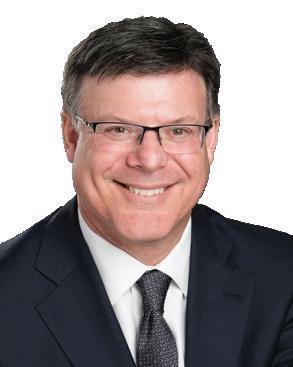
Here were some key findings of the 12th annual Chief Executive Group compensation survey for private companies that Cooper and Isabella Mourgelas, research analyst for the company, shared with the summit participants:
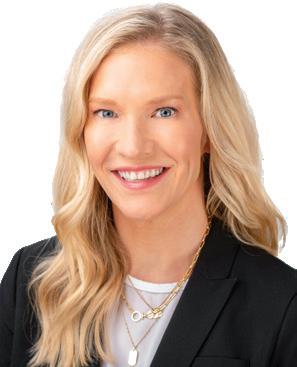
• Median CEO pay was $445,000 in 2021, up from $386,000 in 2020, during the worst of Covid.
• Wages being demanded by new recruits were the most common factor that materially impacted compensation in 2022, with 74 percent of the survey’s 1,849 respondents putting it at the top. The need to help employees keep up with the cost of living was second, at 65 percent.
• Reducing costs in other places was the most common action being taken in response to rising wages, with 67 percent of CEOs doing so.
Profit from the experience of your industry-specific CEO peers.
Chief Executive Network (CEN) allows you to profit—personally and professionally—from peer CEOs in your industry who have first-hand experience with the challenges and opportunities you face and are committed to your success.
As the CEO, you are uniquely responsible for synthesizing technology, customer, competitor, societal and economic trends. CEN provides peer and expert perspectives that can help drive your organization’s future.
Maximize your effectiveness in minimal time.
In just a few days a year, you will identify and concentrate on those initiatives that can have the greatest impact.
Call Rob Grabill
323-3716 or visit
Each peer group meets in person and online several times per year—and members also have access to world class conferences, a network of over 500 members, as well as subject matter experts.


This enables our busy members to tap the collective experiences and knowledge of the network to make better decisions, faster, and to avoid costly mistakes.
Find out more today.
What could your organization accomplish if you could peer into the future?
BECOMING AN ENGAGED and em powered leader can be a matter of closely following an acronym.
“It’s not necessarily ordering people what to do but pulling the best efforts out of people,” said Zach Clayton, a millennial entre preneur; CEO of Three Ships, a digital-marketing agency in Raleigh, North Carolina; and co-author of True North: Emerging Leader Addition with Bill George, who was the agency’s first client. “Emerging leaders in the millennial and Generation Z generations respond much better to that style of leadership.”
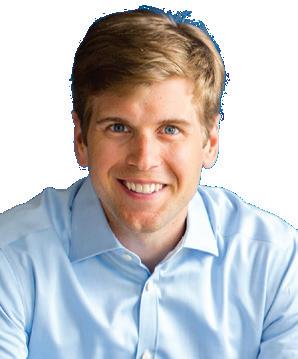
Clayton summed up the key acronym—COACH—for the summit.
C: “Care about your teammates. You need deep connec tions and personal relationships,” he said. “Do you know about their life outside of work? Out of caring relationships
comes a foundation of trust.”
O: Organize people “around their sweet spots,” Clayton said. Get people working together by putting them in wellmatched roles that allow them to collaborate effectively.
A: Align charges around “their mission and their work as a team,” he said. “Why does the business exist? Make sure they understand that, beyond making money. How does it make a difference in people’s lives? Paint a vision and cascade that through the organization [in a way] that is so vivid people can taste it.”
C: Challenge employees by seeking the best out of them “so they can reach their full potential,” Clayton said. Encourage them to “watch their game tape,” like a football player the day after the game, so they can do better.
H: Help people by “rolling up your sleeves and getting on the same side of the table” with employees, he said. “Add value. Is there a contact you have that can be useful? Something you can model?”
ARTIFICIAL intelligence and machine learning are advancing so fast the technology is now accomplishing feats experts dismissed as never reach able just a few years ago. But those technological leaps mean the unfolding of more occupational opportunities for humans, not the end of work as we know it, argued summit keynoter Andrew McAfee.
“We’re early in the era of weirdly fast progress in AI, in areas where it had historically been bad,” said McAfee, cofounder and director of the MIT Initiative on the digital economy and author of The Second Machine Age: Work, Progress, and Prosperity in a Time of Brilliant Technolo gies. “But should we prepare for massive technology-related unemployment? Even with all of this astonishing progress, the answer is pretty clearly no.”
Here are things McAfee suggested company leaders should keep in mind in adapting rapidly improving AI to their needs.
You needn’t be afraid. “In addition to substituting for human labor; [technology is] also a complement,” he said. “It increases demand. It helps start new companies and industries. They still need people. We don’t have a personless organization yet. I don’t expect to see a peak-labor economy in a time frame we all need to worry about.”
Obsolescence will transform IT. Existing digital tools, McAfee said, “in general are too clerical in nature and not helping us address the real challenges. I look around and ac tually think that people doing jobs are being poorly served.”

One of the most problematic areas of IT is enterprise software, he said. A venture capitalist told McAfee that
“most of it still sucks. We should be expecting a superpower from it, letting us do something we have real difficulty doing ourselves. AI is about to disrupt lots of different kinds of enterprise software.”
Talent software is improving. The data available on human-capital measures and trends “has gone up by leaps and bounds in the last 10 years,” including not only better government data on job markets but also online platforms such as LinkedIn, Glassdoor and Career Builder that bring qualitative insights.
But McAfee and colleagues are among those developing what he calls “radar systems for talent” that soon will be able to collect and analyze clues and signals about job desires, career trajectories, markets for skills and com pensation patterns that will help companies optimize their hiring, training, promotion and development.
Scale isn’t everything. Not surprisingly, Amazon, with its nearly limitless computing power and market dominance, is on the front lines of harnessing AI to create yet more dominance. But McAfee urged attendees with smaller companies—which was just about everyone at the summit—not to be discouraged by the competition for taking advantage of AI’s capabilities.
“Amazon reached out to us because they don’t have their own capabilities, or we’re cheaper,” he said. “We’ll see spe cialized startups that can help [your companies] with some of these questions at first, so you can get AI-based insights.”
It’s already here. Despite the limitations it still suffers, AI already has transformed many aspects of work and life. “There’s [no] reason to walk away from this burst of progress or to be frightened by it,” McAfee said. “Think of all the ways life has already been improved by it.” CE
If you were going to have dinner with Jim Collins, what would you ask? This is your chance to go deep with Jim and get his take on the most important, specific challenges of our time. Workshop your best ideas with other CEOs during this half-day session to:
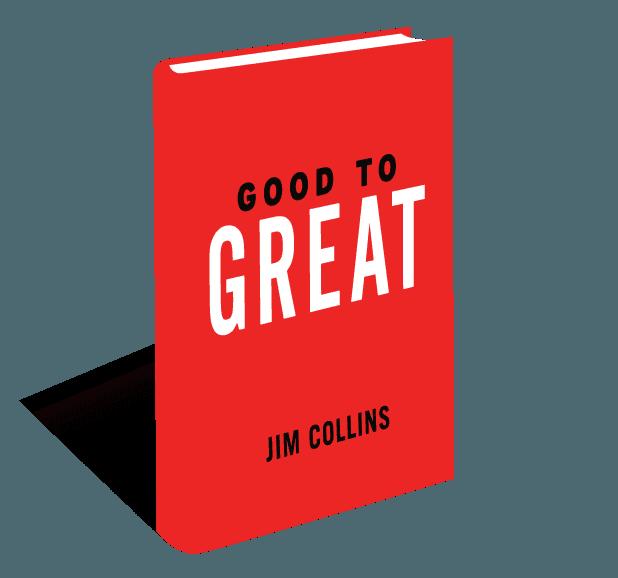
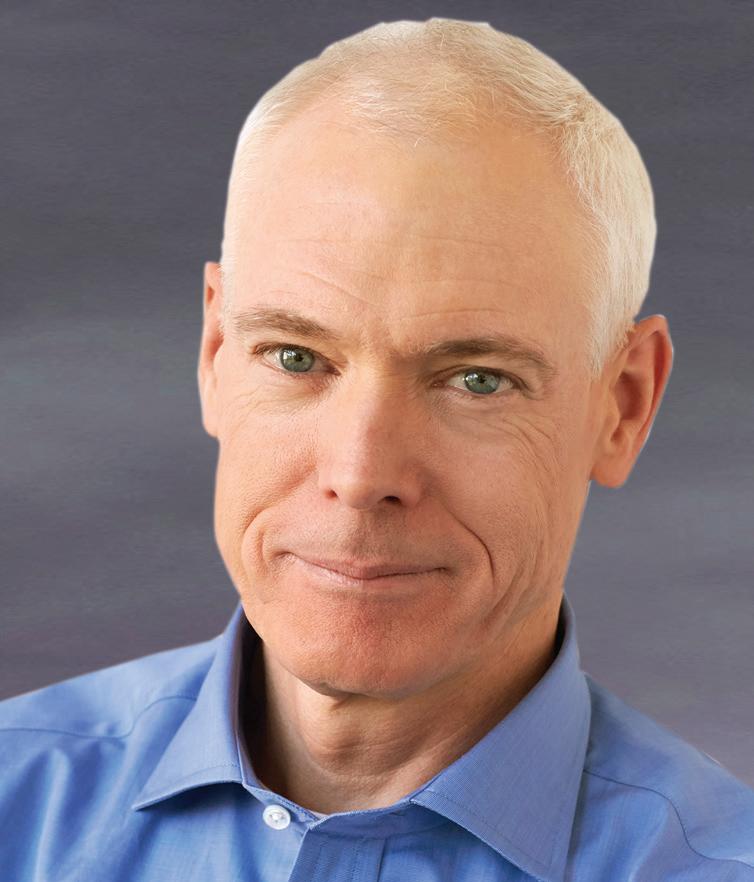
Gain outside perspectives that help your company grow, no matter the conditions

Create a plan to put new concepts to work to improve the long-term future of your business
Develop your company’s Flywheel—live, in real time—with Jim’s coaching and the unfiltered feedback and input of your CEO peers
CEO Garry Ridge wanted to avoid the loss of top performers during WD-40 Company’s leadership transition. Here’s how he did it.
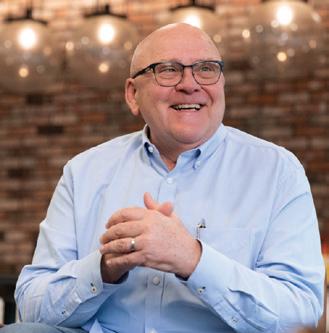
“NEVER SAY NEVER!” That’s a mantra every leader knows in their heart about their leave-taking. Not only may departing be hard on a CEO, but it can also be difficult for the organization, particularly if that leader is respected. Employees crave certainty, and when the top person leaves, that disruption can create a sense of uncertainty.
What’s more, in cases where there are a few candidates, the company can lose valu able talent once a winner is anointed. Avoid ing that scenario was essential to me as I considered how and when I would leave the CEO post at WD-40 Company after more than two decades. Culture is the glue that binds all of us together at WD-40, so I knew that in addition to growing the business, my successor would have to nurture the culture. For example, managers at the company are called coaches; their role is to develop others, including their successors.
Preparing a successor may be considered your last gift to your company. It’s how you ensure that what you helped to build has a foundation upon which to grow stronger and wiser. Consider it an act of grace. You are enabling the leader and successor—as well as the organization—to feel comfort able and connected.
Foremost, you want to make sure they can do the job. My daughter Kate, who teach es dance, says the only way to prepare a dancer for Broadway is to have them dance Off-Broadway. See what they can do on a small stage to prepare for the main stage.
Preparing the organization for the next leader is essential. People become accustomed to the way the person at the top does things— which changes when a new person takes the helm. That’s where preparation occurs. When we made Steve our COO in 2019, it was clear he would be my successor. He would be mak ing more and more of the big decisions.
Then, just as Steve was taking over, Covid struck, disrupting businesses worldwide. Uncertainty was the watchword. I was fortu nate to be able to work with Steve so closely. I like to say that Steve was in my sidecar, which meant he experienced the dips and bumps right alongside me on our road to recovery. The pandemic was and remains a tragedy, but it enabled us to see Steve—as well as our entire leadership cohort—act positively in the toughest of times. You could say they were our “master mariners,” women and men who could and did sail the roughest waters in the harshest of weathers.
Looking back on our journey together, I want to share a few thoughts on what it takes to leave in the best way possible.
• Be generous. Share what you know with your successor. Give them a peek behind the curtain to see what’s expected of the person holding the top post.
• Be compassionate. Understand that you are stepping aside. Let others know what you see in your successor. Help others see them as you do.
Garry Ridge, former CEO of the WD-40 Company, now runs the Learning Moment, a coaching and consulting firm. John Baldoni is an executive coach and author of the forthcoming Grace under Pressure: Leading Through Change and Crisis.
At WD-40, one CEO candidate, Steve Brass, began to stand out over time. He proved him self a success on every stage, so there was only one place for him to be—the U.S. That would mean moving himself and his family from the U.K. Having moved to the States along with my family from Australia in the early ’90s, I wanted to make sure Brass’s family would be comfortable living here. Fortunately, the move worked well for all parties.
• Be courageous. I like to say that what I did was “train my assassin.” That is, I per mitted him to lead in his way. He is not me. He is Steve, who will have his own voice, and I know he will do what’s best for the tribe and the WD-40 Company.
Finally, know this: What you thought might never come has arrived—so it’s time to get on with your next chapter. In the words of singer-songwriter Tim McGraw, “We all take different paths in life, but no matter where we go, we take a little of each other everywhere.”
CE

